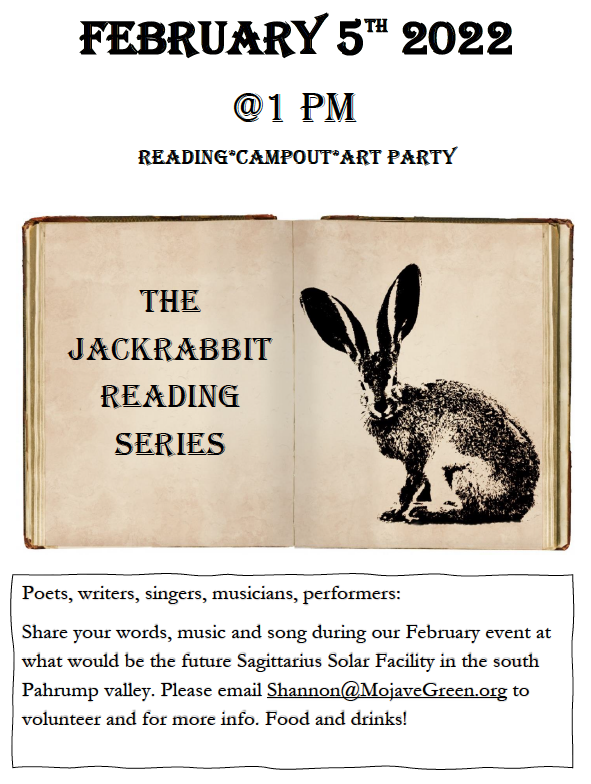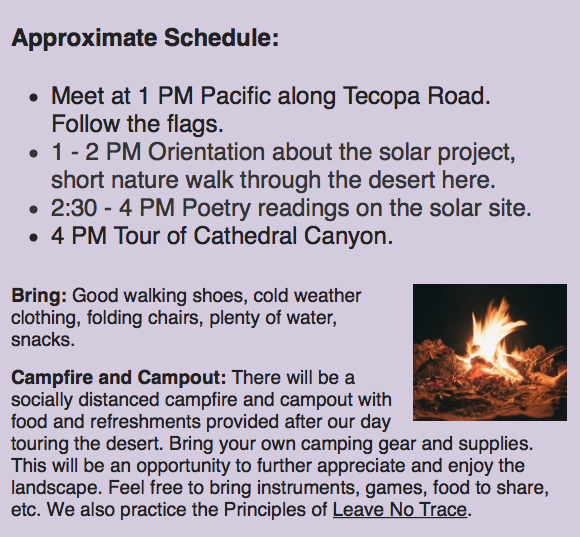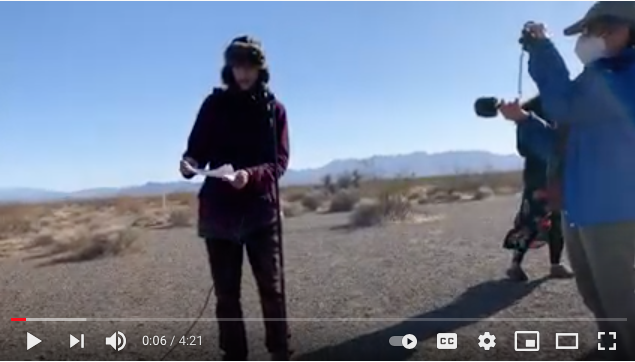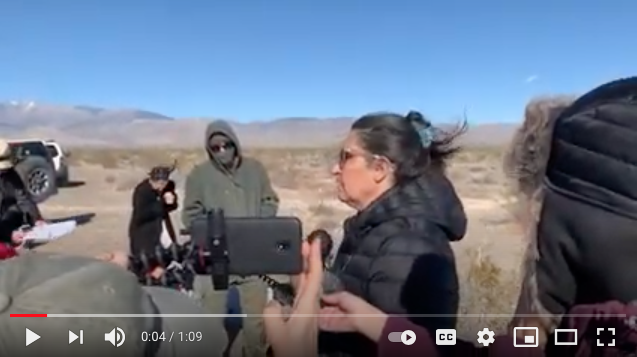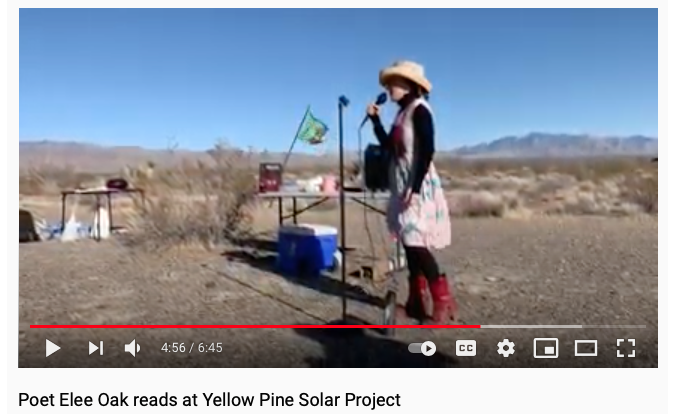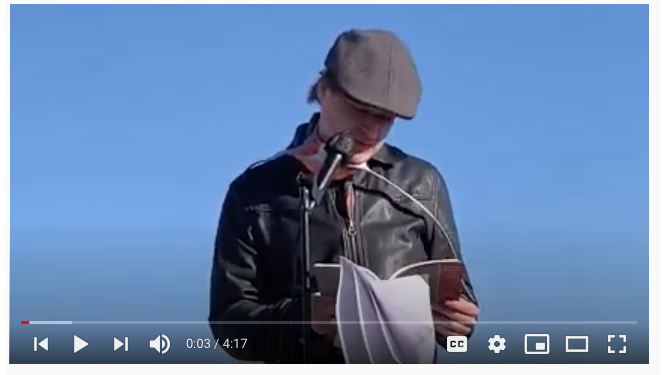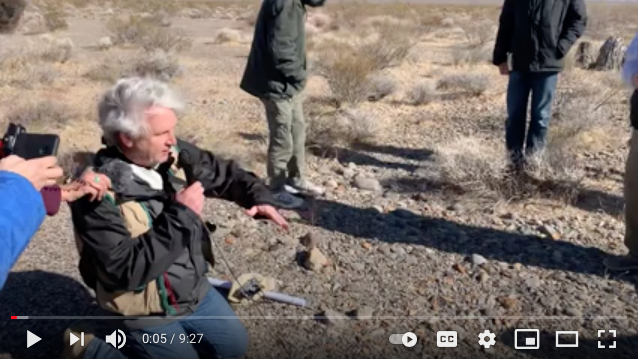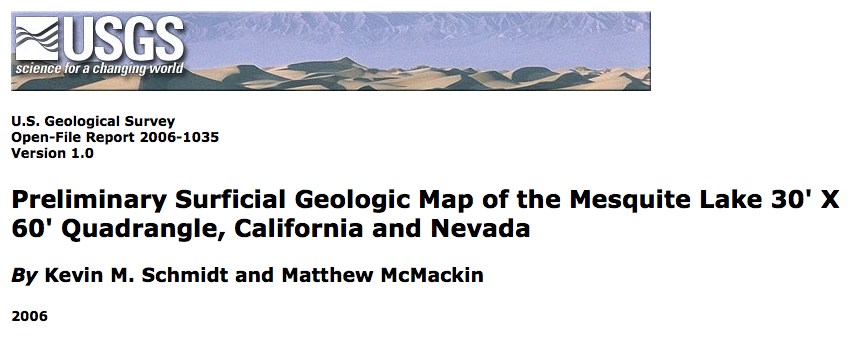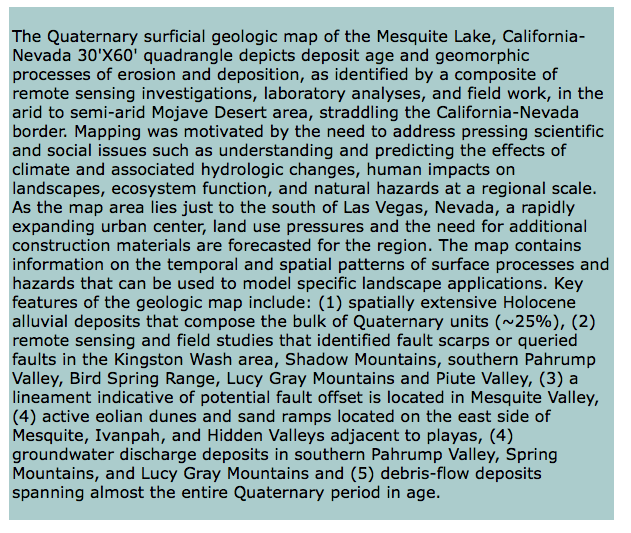February Jackrabbit Reading
January 6, 2022 - Pahrump Valley, NV - Join us for another sereies of readings in opposition to utility-scale solar development of the beautiful Mojave Desert south of Pahrump, Nevada, with Mojave Green and Basin and Range Watch.
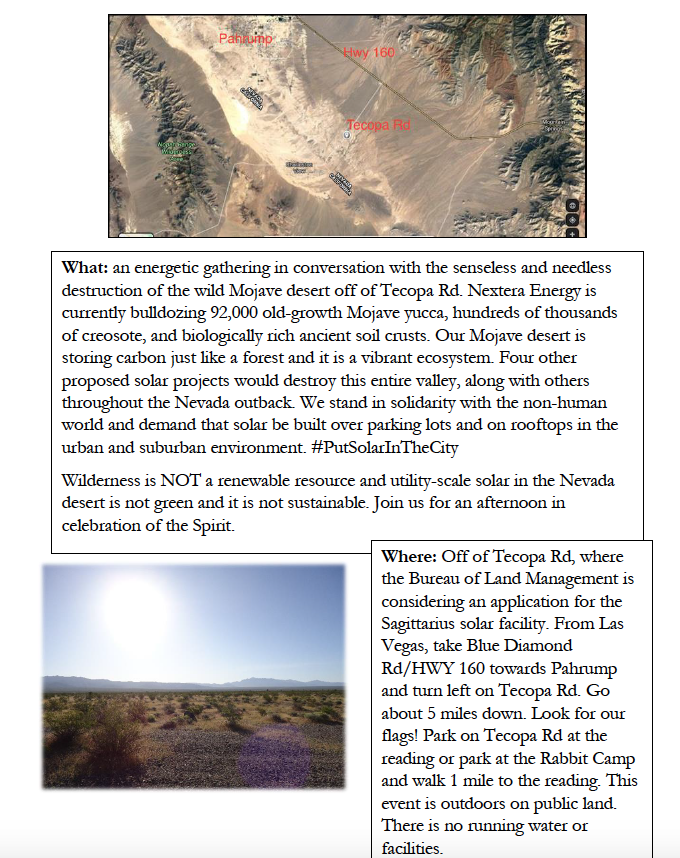
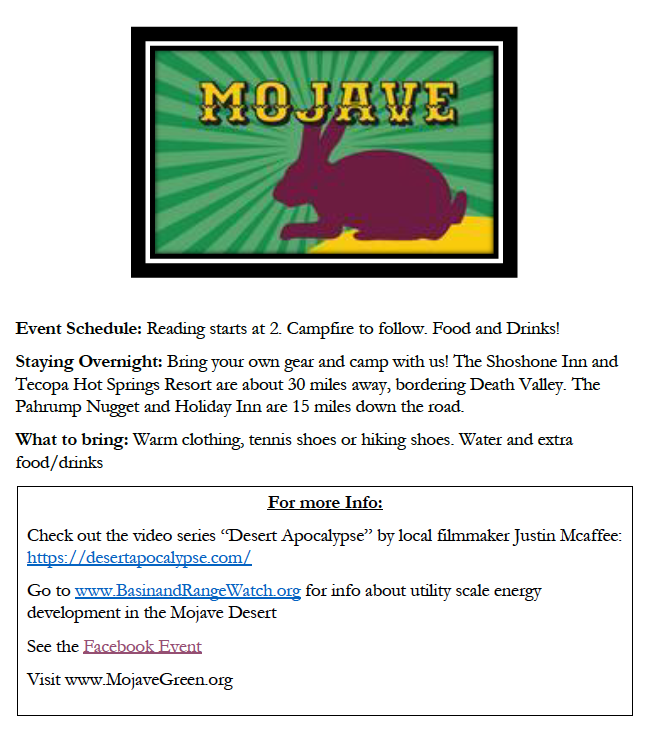
See Desert Apocalypse the film.
YellowPine Solar Project November 20 Event!
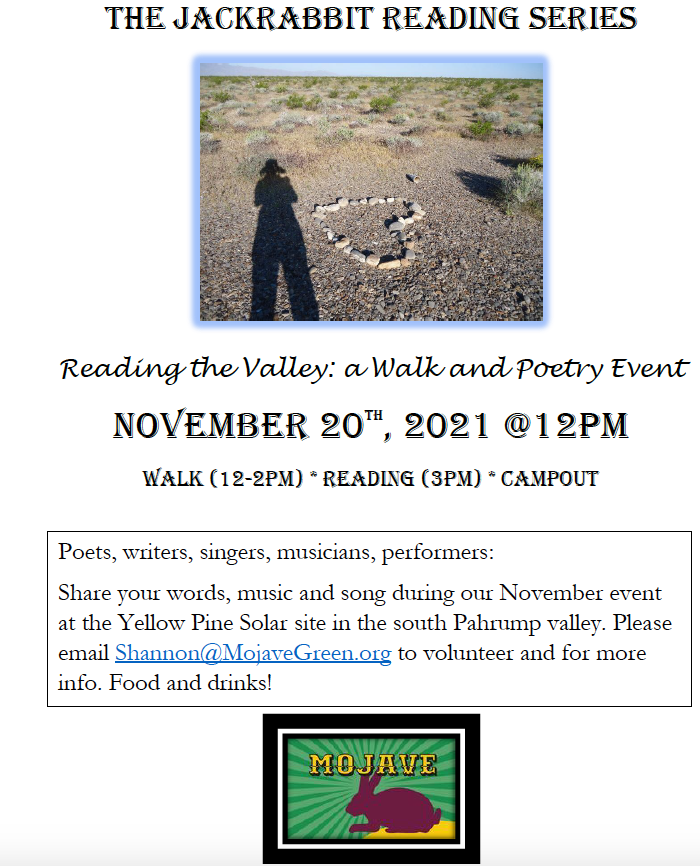
November 8, 2021 - Pahrump NV - Activist Shannon Salter presents her third Jackrabbita Reading Series event at the site of the utility-scale Yellow Pine Solar Project now under construction, to bring awareness to the other large-scale solar projects proposed to be built in Pahrump Valley on adjacent public lands.
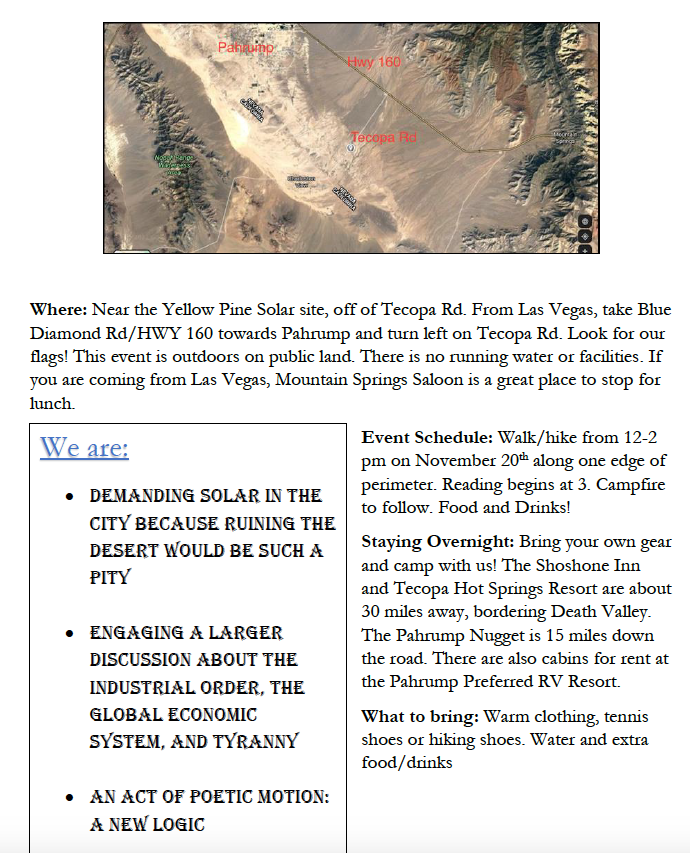
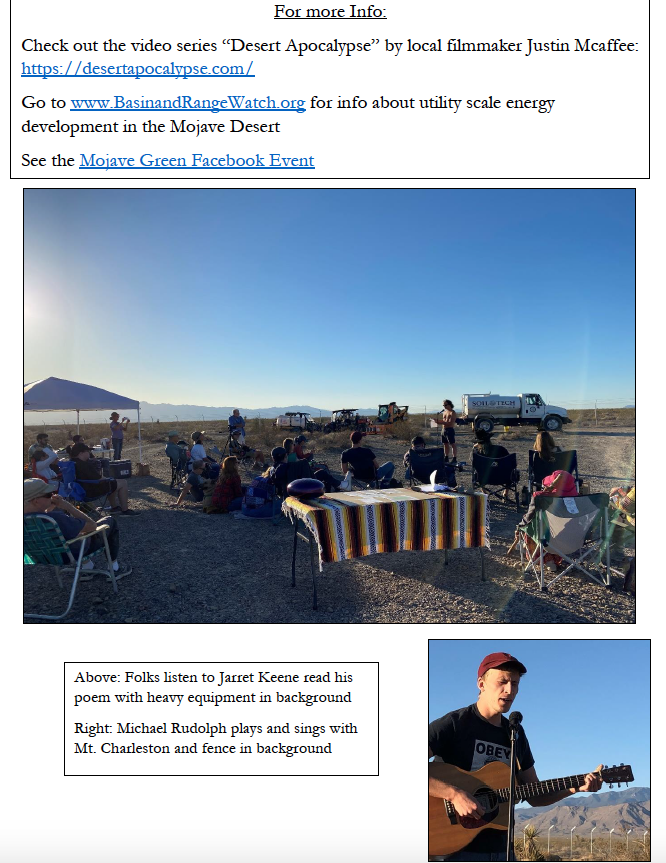
Poetry in the Desert Press Release
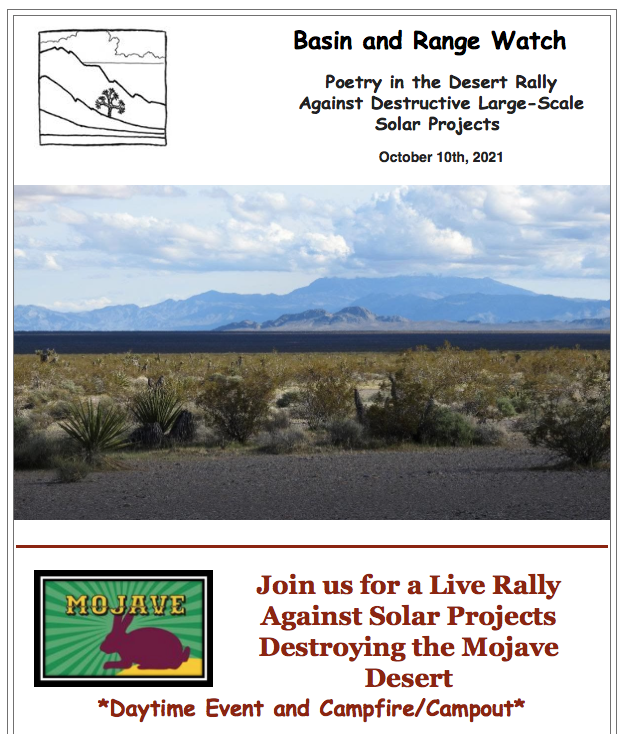
Poetry In The Desert: Kickoff for Pahrump Valley Vigil and Camp Opposing the Yellow Pine Industrial Solar Project
October 10, 2021 Press Contacts: Shannon Salter 949-278-5536, Judy Branfman 310-392-2076
WHEN: Saturday, October 16, 2021: 2 pm Gather, 3 pm Biologist & Cultural presentations, 4 pm Poetry/Readings, followed by campfire and campout.
WHERE: Off Tecopa Rd, 3 miles west of HWY 160 between Las Vegas and Pahrump, Nevada --- Look for flags along Tecopa Rd
WHAT: Poetry readings, scientific presentations, campfire, and camping: writers, artists, environmentalists, and desert lovers will challenge the destruction of pristine carbon-sequestering desert adjacent to wilderness lands and Death Valley
At 2pm on Saturday, October 16, 2021, Poetry In The Desert will officially kick off an ongoing vigil and camp in the Pahrump Valley to oppose Nextera Energy's plans to begin “moving ground” on the 4.5 square mile Yellow Pine industrial solar project on pristine, carbon-sequestering, public land that is adjacent to and will severely impact Kingston Range Wilderness and Death Valley National Park.
Featured poets and writers include Claire Watkins, Jack Pritchett, and Shannon Salter, and biologist Laura Cunningham.
In the midst of major climate change events, the ability of the Mojave Desert’s unique, complex microbiotic soil crust to sequester carbon must be valued and prioritized, along with rooftop solar and using already disturbed lands for large solar projects. The Yellow Pine project will scrape the desert flat, destroying 93,000 Mojave Yucca, some as old as 500 years, valuable wildlife habitat, and the carbon sequestering soil. Nextera has already displaced 139 tortoises from the site, 26 of which were promptly eaten by badgers. Three additional, even larger projects are proposed nearby, along with others across Nevada (and additional projects nearby in California) that will total hundreds of square miles.
See the video series “Desert Apocalypse” by local filmmaker Justin Mcaffee: https://desertapocalypse.com/
Go to www.BasinandRangeWatch.org for info about utility scale energy development in the Mojave Desert.
Background article: https://reno.newsreview.com/2021/05/22/the-tortoise-vs-the-bulldozer/
October 16 Poetry Reading at the Yellow Pine Solar Project
September 18, 2021 - Please join Shannon Salter and other readers at the site of the approved Yellow Pine Solar Project in south Pahrump Valley, Nevada, for poetry, campout and art party. THIS WILL BE FUN!
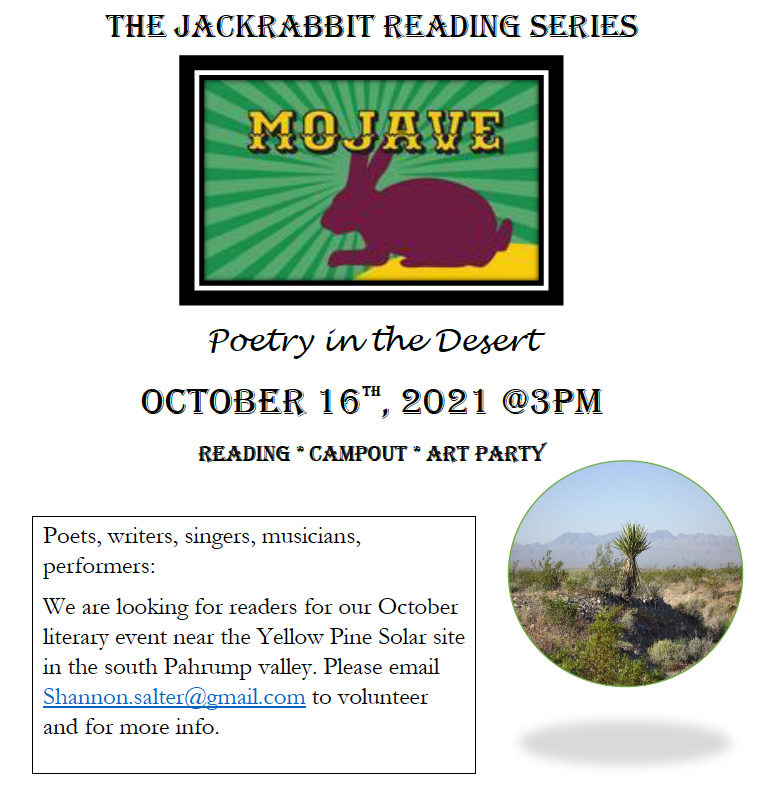
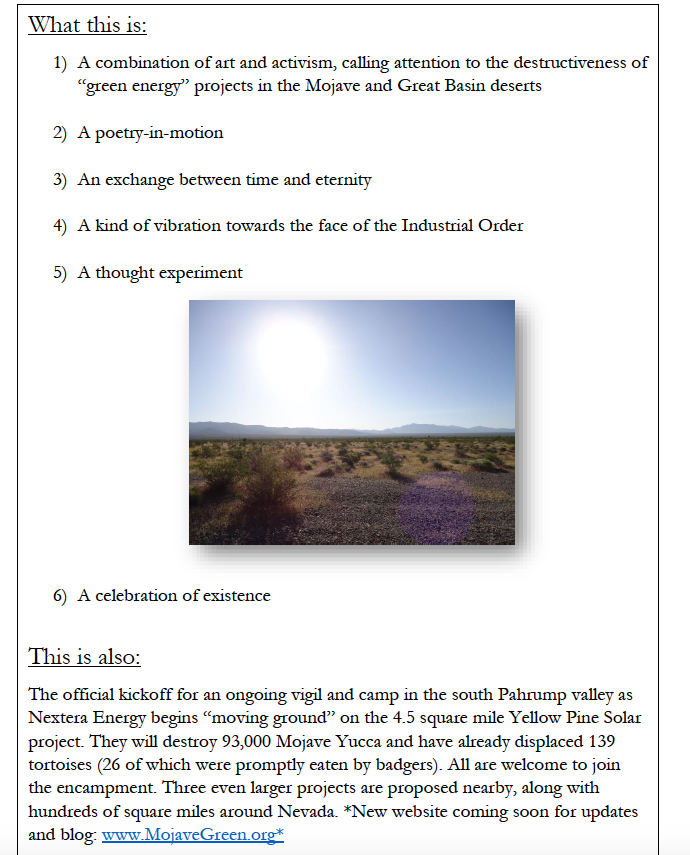
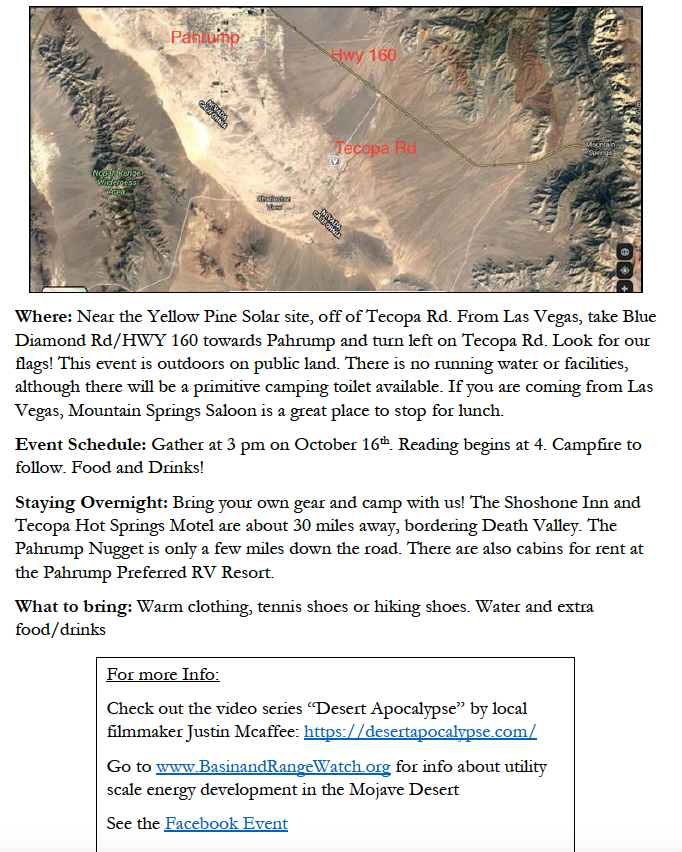
Please support Shannon at https://givebutter.com/ProtectPahrumpValley
Yellow Pine Poet Rally!
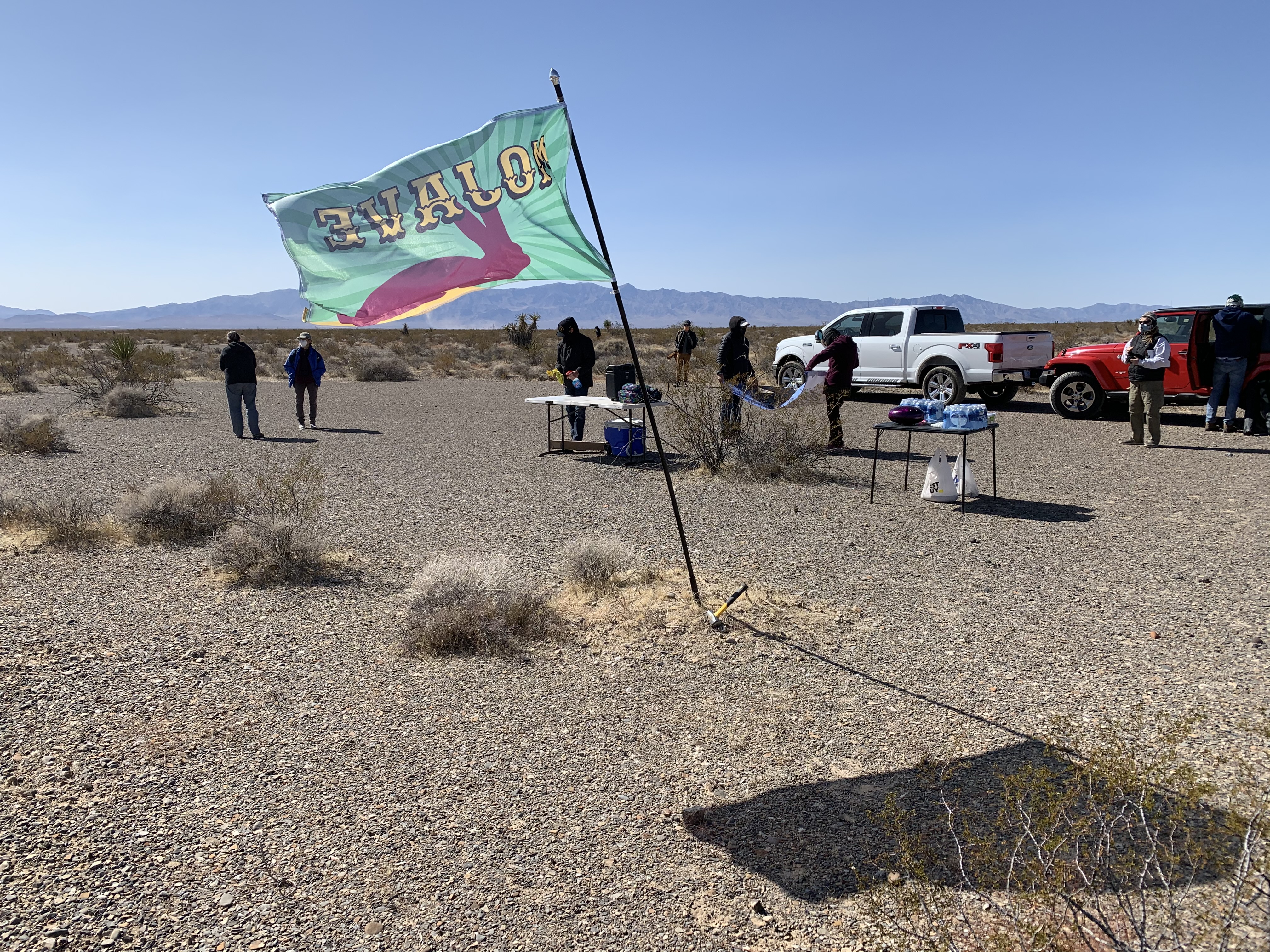
^We set up on a windy day in late February on the project site soon to be bulldozed.
The announcement:
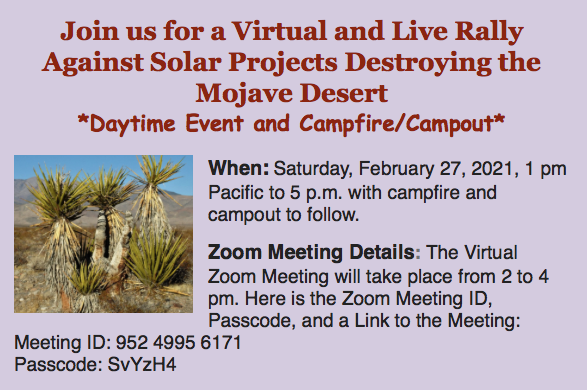
^Professor, author, and poet Ruth Nolan with Laura Cunningham, cofounder of Basin and Range Watch, discuss how large-scale solar projects should not be built on such pristine public lands Mojave Desert ecosystems. Photo: Judy Branfrom.
February 27, 2021 - South Pahrump Valley, Nevada - Basin and Range Watch held a live and virtual gathering along the Old Spanish Trail Highway at the Stump Spring turnoff to bring attention to the grand plans to industrialize the entire area with 5 large-scale solar project and a new substation and transmission lines. One project, Yellow Pine Solar, has already been approved by BLM and will destroy 90,000 old growth Mojave yucca plants on 3,000 acres (4.6 square miles) of lands owned by the Bureau of Land Management. In total, there are 5 more proposed solar projects in this area. One for the California side and 4 for the Nevada side. In total, over 17,000 acres are being considered for development of huge solar projects in the region. We estimate that over 600,000 Mojave yuccas, 30,000 Joshua trees and 2,000 desert tortoises would all be impacted by these plans. Also being sacrificed are archeological sites and public access to BLM lands.
In addition, Congress recently passed a spending bill that included building five times the current number of renewable energy projects on public land by 2025. We need an urgent discussion about where to build this infrastructure, and how to do it without ruining our desert ecosystems.
Poetry Readings in the Desert
https://youtu.be/n7rG29kjBao - Shannon Salter of the University of Las Vegas, Nevada, reads her poems on the site of the Yellow Pine Solar Project, soon to be destroyed.
The event went well and about 30 people attended despite a cold, blowing desert wind. We held a series of talks, guided walks and virtual tours of the area. For live participants, this was a socially distanced event and masks will be encouraged.
We talked about the flora and fauna, geology, the cultural history, the plans to develop the area, what impacts to expect and sane alternatives to destroying this beautiful old-growth desert region.
https://www.youtube.com/watch?v=rPM74PNPrgU - First Mojave Desert Literary Laureate Ruth Nolan, talks about cultural issues and the desert removed for utility-scale solar projects.
Shannon Salter, Basin and Range board member, said the purpose of the event was to raise awareness “of the massive amount of public land and wild ecosystems that stand to be lost,” and initiate an urgent discussion about how to construct distributed energy within the urban and suburban environments, such as on rooftops and solar shade canopies.
“The event is about rethinking large-scale solar and quickly transitioning to a mentality focused on incorporating solar in urban and suburban environments,” Salter said.
The nonprofit also wants to raise awareness about the new science that says “desert soils are sequestering a significant amount of the carbon from the atmosphere,” Salter said.
Group holds event to raise awareness of proposed solar projects | Pahrump Valley Times (pvtimes.com)
https://pvtimes.com/news/nonprofit-holds-second-rally-against-large-scale-solar-projects-97011/

^Shannon Salter reading her poetry with a tortoise exclusion fence stake in the background.
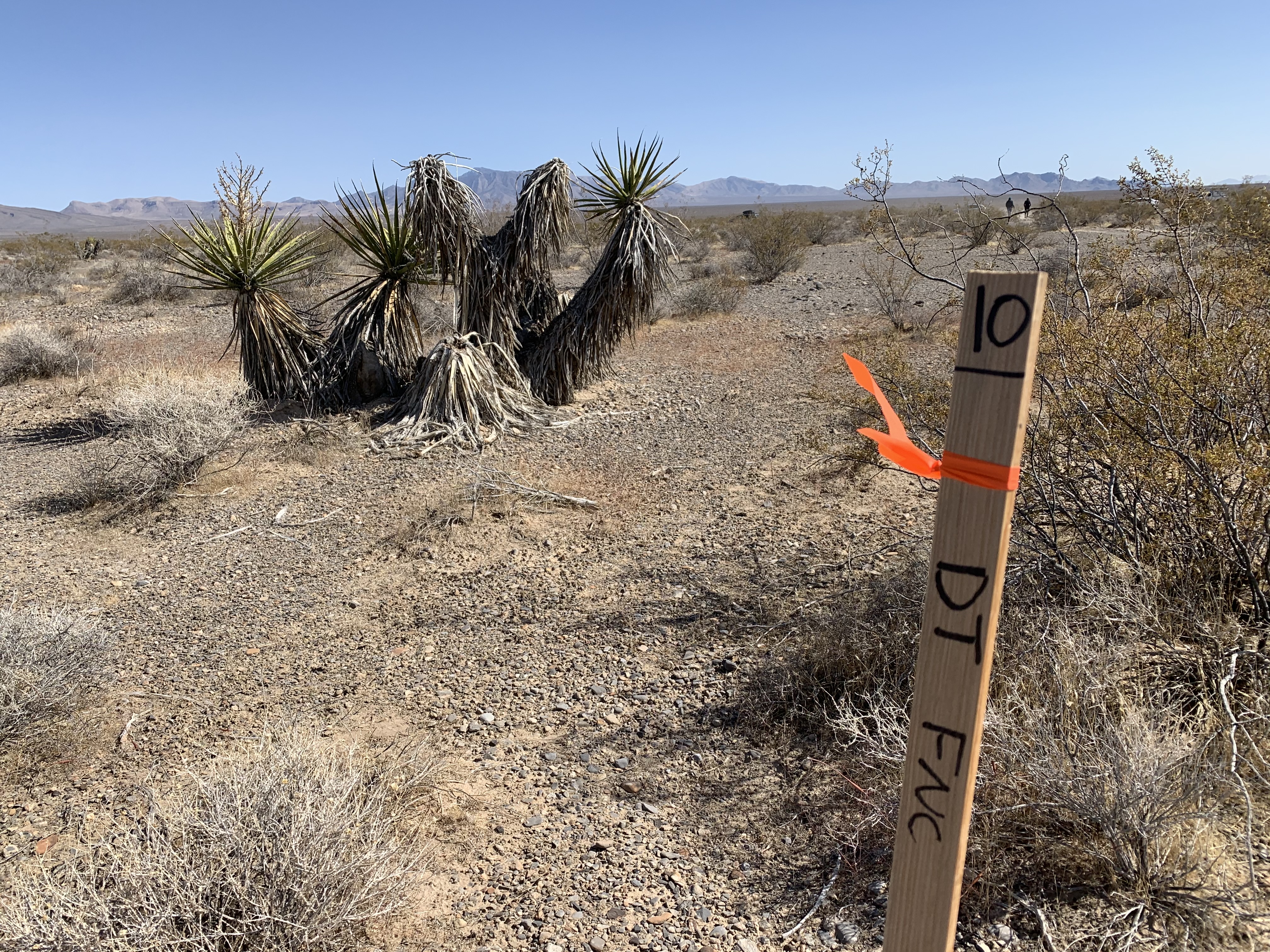
^The survey stakes were up for the exclusion fence that will allow digging tortoises up out of their burrows and translocating them off the solar project development site.
Shannon Salter's Poem:
Jackrabbit,
you are my brother!
The blue whale burst off inside you
The white sun
It is 1905 and America has built the Union Pacific Railroad
And the heart of God has put his face onto the cement
Kissing the Earth, he calls to the First Light:
Thou are
And to the sky he shows his body
And to the river
We are here to honor each other as well as the land
And the invisible majesty which we cannot see
We are here to call forth a new way of Being
A new sound, a new silence
A new world
Having a clear vision,
I become dizzy with a sense of joy
My heart is broken, my mind
Empty
This valley is alive.
This valley is the face of God.
I must believe in what is possible, that the kingdom is within us, that we are strong, that we can build a world which does not destroy Life, that does not insult the living, that does not forsake the dead, nor the unborn. {I believe in a coming revolution of things that will make everything which has come before turn red with shame.}
I believe I am this Yucca. I am this stone.
10,000 years ago the ancients dwelled in these valleys. They are the Pipa Aha Macav, the people beside the river, and from this the great Mojave takes its name. 10,000 years ago this was not a desert, it was a lagoon, and before that it was the ocean.
Time is standing still. Time is stopped.
The dead are with us.
Reach inside the river and that is the Great Spirit.
I believe in the human spirit. I see you. My heart is broken and my heart is strong, it lives and breathes.
The psychologist C.A. Meir writes that, as wilderness is destroyed, it does not disappear. Instead, it moves inside the human mind. It opens a space. He writes that the hole is opening larger and larger in proportion to the vast swaths of wild being erased, so that the whole of western civilization is on the verge of a psychological break.
Nothing disappears.
I know I am.
I need the open sky like I need my brother. Like I need my Friend. I need the open valleys and the mountains around us without which we would belong nowhere, become a people without a place. This valley is a bowl, and the mountains around are what keep us. in place
Our sky is a miracle.
Go all the way in. Go to the center, go
to the beginning.
These yucca are my brothers and sisters.
How dare they kill my brothers and sisters.
This soil is my oldest friend.
How dare they take my oldest friend.
Terry Tempest Williams writes that:
“The eyes of the future are looking back at us and they are praying for us to see beyond our own time. They are kneeling with hands clasped that we might act with restraint”, that we might leave room for the life that is destined to come. To protect the wild is to protect what is gentle. Perhaps the wildness that we fear is the pause between our own heartbeats, the silent space that says that we live only by grace. Wilderness lives by this same grace. Wild mercy is in our hands.”
It’s in our hands. It’s in our blood and bone and it’s in our eyes and hearts and there is only
the big moon listening
the big sun watching,
the river taking us in its long, wet mouth.
I will go with you.
I will give you my body. I will give you this stone.
The mountain reaches forward through the cloud of angels
This is our home
This is the secret ministry
of birds and prayer
This is an echo around the immortal rim
Origin of love beyond, when God became empty
My heart is broken and it is strong, in death it lives and breathes
And the rabbit is spilling itself through a viscous silence, and the fox is nesting in the field.
Remember the wind.
Remember the wind.
The dead are with us. The dead are filling this valley.
And in the words of Yves Bonnefoy:
So we will walk on the ruins of a vast sky,
The far-off landscape will bloom
Like a destiny in the vivid light.
The long-sought most beautiful country
Will lie before us, land of salamanders
Look, you will say, at this stone:
Death shines from it.
Secret lamp it is this that burns under our steps
Thus we walk lighted.
And, finally, in the words of Juan Gelman:
Death itself has come with its documentation
We’re going to take up again
The struggle
Again, we’re going to begin again
We’re going to begin all of us
Against the great defeat of the world
Little companeros who never end
Or who burn like fire in the memory
Again and again and again
About a yellow ball
The rubber was a from a tree in Sri Lanka
The tree was from a seed
Seed slept until soil woke it
The yellow was from the high leaves
The yellow was from sun falling on the tips and backs of
Slender green
The yellow contained no phthalates
The yellow was shy but only
upon waking
The yellow always said
Yes
The air was a miracle and a mystery
No one knew how it got inside
The good hot air
The air was captured but it was glad
The air had nowhere else to be
Time
Was slowly drawing the air out
Slow and easy
It didn’t hurt the rubber or the yellow
Someday all the air would be gone
The air would go someplace else
The yellow and the rubber
Would go back to sun
And back to seed
Time
Would keep their song
I walk far enough from Nipton that our radios don’t work well. We can hear each other but it seems not easily. I walk past the power lines into the wilderness boundary of the Mojave Preserve. I sit on the grey stump of a downed yucca. Its fibers are tight around its core. The stump is one part of an ancient ring come out of itself, and behind me, a cholla cactus glowing with sun. The glow in the cholla’s arms comes from the sun’s light, and it comes from within the cactus itself. It is a warm glow, and yet it has a metallic sheen. The glow is not unlike a swimming pool, when the night is wrapped around the blue water. There are little foxes here, called kitfoxes, and they meander quietly into your dreams. They nibble at the bedsheets, and they make a nest in your clothes on the floor.
How long has the arm of this yucca been down? 100 years, 1000 years? Surely in 1000 years it would have gone back to dust, back to the river.
This summer, we saw a rattlesnake at 8000 feet near our campsite in the Los Padres forest. A high altitude for a snake of that measure. He was brown and green and his body was hard to see on the forest floor. We ate ramen on our portable stove. We hiked to the Chumash creation mountain and when we got to the top there was a clap of thunder like I’ve never heard before and I jumped, and my skin became alive; my ears rang. It was the same afternoon that the Cima Dome fire started in the Mojave Preserve with a flash of lightening, a strike, a most unusual event, and 43,000 acres in the Wee Thump Joshua Forest burned. The Ancient Ones became black ash. Nothing goes away. What does it mean that at 3 pm on the 15th of August, 2020, you were at the center of the universe, and the thunder just overhead went inside of you, perhaps at the very moment that fire from the sky was igniting the Joshua tree woodland around Cima Dome? There is this: vibration that goes beyond time and the material world. The dome which extends from one end of earth to the other, which extends from our lives to the lives of those who came before, and the lives of those who are not yet born. Cima Dome is so named for the curvature of its earth. It is a roundness which can be seen clearly from a small rock mountain called Teutonia Peak. I often hiked there, and for years I looked right at the dome but didn’t know what I was looking at. And this was true for others also. I often overheard other hikers asking “where is the dome?” Everyone looks for a rock formation of some kind, but its not there. It is in the earth itself. You won’t see until you quit looking, and then it has been looking at you all this time. To see is to be seen. I’m saying that it is possible to read the movement of animals, to read the light and shadow, to read even the sky. If I could feel, for one moment, the interior of your voice. If I could feel you lying with me in the sand. You know the desert washes are a
natural bed-place. The sand there is soft and thick, and creosote lends a certain aptitude, and your shadow can sometimes speak volumes.
The tree outside my apartment in Las Vegas is blooming before my eyes. Its pink coming out of circles, the few in the spot at the bottom in the most sun starting to open; tonight I put my hand in the toilet tank to fix it and, within an hour, my thumb began to peel as it did when we put our hands in the river in Varanasi, having seen the shore coming up with people, an odd voracious thing.
The spirit is feeling its way through grass. In the middle of a field, an orange striped cat is wagging its tale, it knows you already, and you know him. The cat has a red bandana around his neck, his name is Charlie, and the river is going back through the canopy, and all is fading into light.
THe Bigelow Space Mansion is surrounded by a pine forest, a ten-foot wall, and the sky around is so blue you want to faint. Darwin is there with his eternity on the sidewalk, and the magnolia are in the business parking lot across the street. When the big slinky comes down it is more than an opening. It is the crows taking fish. The fish was a trout so big we couldn’t eat all of it. It was the fish my nephew caught at Lake Cuyamaca, a fish like no one has ever seen. The leftovers I put out for the racoon that walks on the stucco wall around my parents’ yard, and what was still there in the morning I took to the field down the street. One by one, the crows lifted it off in their black beaks.
To see the fish taken into sky that morning.
In the washes you are in a riverbed and the sand is soft yet firm. The train comes by from some place above you and the sound is a distant land-spill. The metal of the tracks. You rise and can’t quite see it. All you see is light. And the creosote offer small bits of white cotton, their seed. Most all of the plants in Ivanpah Valley will jab you, yet not the creosote. It is fortunate then that she grows abundantly in the washes here so that all around are the most pleasing spots to lie down. To be sure, the creosote can still poke you, but their inner nature is soft as clay. Just yesterday I was stabbed by a Mojave Yucca—through my jeans and a small hole in my leg, which is now sore. The train has been coming through this valley since 1905 and the first ride was taken on the line from Los Angeles to Salt Lake City by senator William Clarke, because often a man is more than a man, and often there is nothing and then, a flash of silver.
Why should we live in pain and suffering? At the end of the world, I become a bee. I go joyfully to walk amongst the blue shadow mountains, where light is coming big and full out of the sky, and to feel the warmth beneath the brim of your sun hat, and beneath your fine jacket. This is the utter stillness of the universe, its pain and dualism, the slow acceleration, becoming fast. At the world’s end is a restaurant so tiny that it only has one table, and four bar seats, and that is if the patrons are sitting very close, so close so as to have their arms brush against one another, in the way that limbs sometimes do when the mind is smooth. The restaurant serves animal meat and
greens from the river valley. Chicken livers and arugula. Quail stuffed with mushroom and bread compote, pasta primavera, fillet.
*
This is the big secret: everything is alive. Not only the plants and animals, but also the ground and the air, the sky, the stone.
It has been proposed that bodies of land be endowed with personhood, and being recognized as such be endowed with the right to life and safety that people have. Lake Eerie has come through this. The lake has gone all the way and out the other side.
In The Open Space of Democracy, Terry Tempest Williams writes of the vulnerability of America’s wild lands and that “they will always be assailable as long as what we value in this country is measured in monetary terms, not spiritual ones” (51). She goes on to write that “the open space of democracy provides justice for all living things—plants, animals, rocks and rivers, as well as human beings” (51).
“Presence creates presence” (Williams, Open Space, 56).
“Humility is the capacity to see” (Williams, Open Space, 57).
“The open space of democracy is not interested in hierarchies but in networks and systems where power is circular, not linear; a power reserved not for an entitled few but shared and maintained by many” (Williams, Open Space, 59)
“At what point do we finally lay our bodies down to say this blatant disregard for biology and wild lives is no longer acceptable?” (Williams, Open Space, 86).
“It is time to acknowledge the violence rendered to our souls each time a mountaintop is removed to expose a coal vein in Appalachia, or when a wetland is drained, dredged and filled for a strip mall” (Williams, Open Space, 86).
“We are in need of a reflective activism born out of humility, not arrogance” (Williams, Open Space, 88),
“Birth as an act of imagination, giving body to a new way of seeing” (Williams, Red, 159).
This evening at the twilight hour, I am sitting, reading in a metal chair outside the Nippeno House, and I hear a rustling in the oleander beside the empty pond. The pond is a white crater in the earth because the town’s previous owners wanted to make the pond a swimming hole and they drained and dredged it. They cut down the oleander on one side so that now from the Nippeno House you see far away into the desert, but you also see the junk yard that the oleander were once shielding from view. The empty pond is a crater in the earth, in this Mojave village.
I believe the sound in the leaves to be a crow, but a minute later a coyote emerges. He descends into the empty pond, all the way to the bottom, and he walks up the other side. He stops to look at me. I stand to get a better look at him. We are both still like that for some moments, just looking at one another, and I wave and I take off my hat so as to accentuate my animal nature and to make him feel at ease. He turns and walks on towards the creosote, towards the castle peaks that protrude in the golden hour like the sound of an eagle’s cry at Sam’s Town, even the eagle you hear from slot machines on the casino floor; the sound which comes from inside and leaves your own ears the way it came. A naked, phosphorous sound. Two more times the coyote pauses and turns to look at me. I am a presence. I am an animal, a breathing, warm thing. I wonder if he sees my imagination. I am certain that he hears my thoughts. I tell him that I love him, to never leave, to stay.
I open the door and find everything
The little boy’s feet are dirty
Wash them
One space leads to another
You are walking onto the future site of the Yellow Pine Solar project between Las Vegas and Pahrump. Las Vegas which was named “the Meadows” by Spanish explorers, and Pahrump which means “water rock”— “pah” meaning water and “rumpi” meaning rock. In many places around Pahrump you can still see a nearly extinct fish in the spring water. They are various species of pup fish. The Pahrump and the Shoshone pup fishes. At the Shoshone campground, you can see this fish in a stream running through the little camp, near the spring-fed pool made by an Indian elder in the 1930s. The little fish are coming down in the warm waters.
You see, people traveled from water-place to water-place, just like we do today.
It is the 24th of February, 2021, and at this time next month there will be fencing around the site preventing public access, and preventing the desert tortoises from going back to their burrows. Because that is what they do. They go back. They listen to the moon which is on their body, which is in their skin. Nextera energy already has the permits to clear the tortoises from the project site, so biologists will go and take them from the burrows. How do they get in there? And what do they say to the poor chaps when they find them? “I’m going to take you now.” “Come with me if you want to live.” It is said that when the tortoise is frightened she gives up her water, and it will take months to rebuild her supply, and in this time, she might die.
So we will walk on the ruins of a vast sky,
The far-off landscape will bloom
Like a destiny in the vivid light.
The long-sought most beautiful country
Will lie before us land of salamanders.
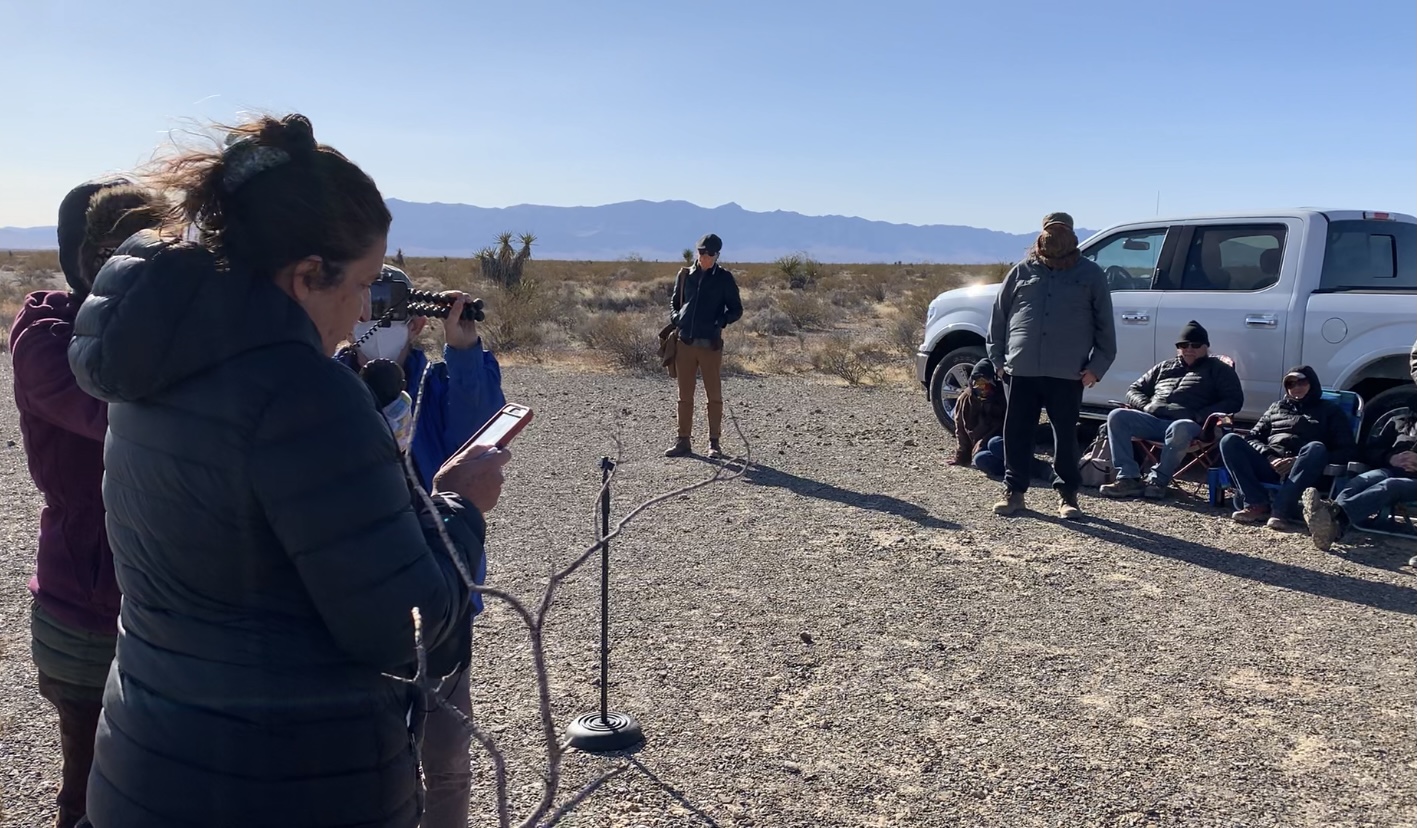
^Ruth Nolan reading her poetry.
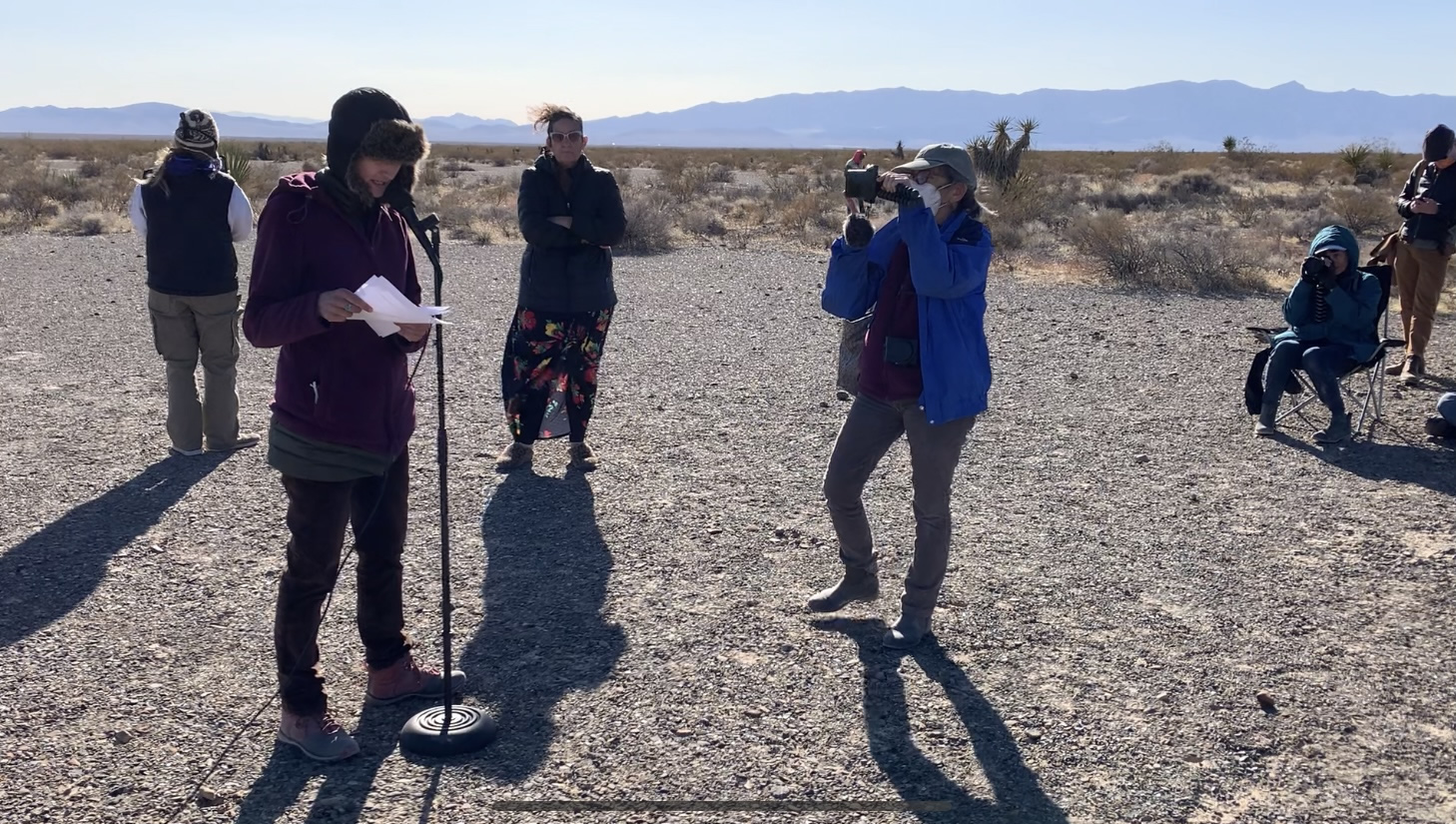
^Shannon Salter reading.
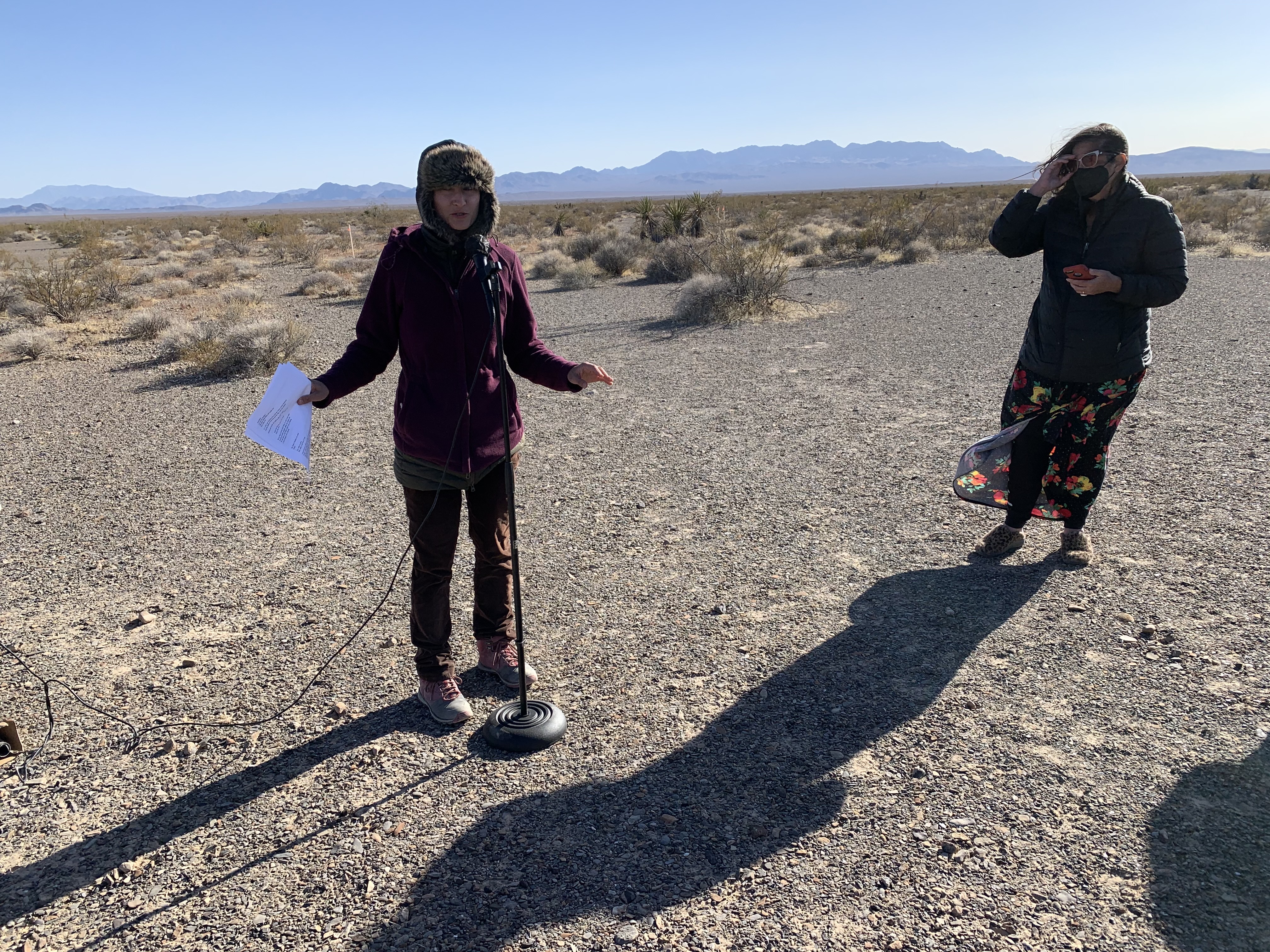
^Shannon Salter and Ruth Nolan.
^The audience of people who came to the desert to hear poetry readings and support keeping this Mojave Desert scrub intact.
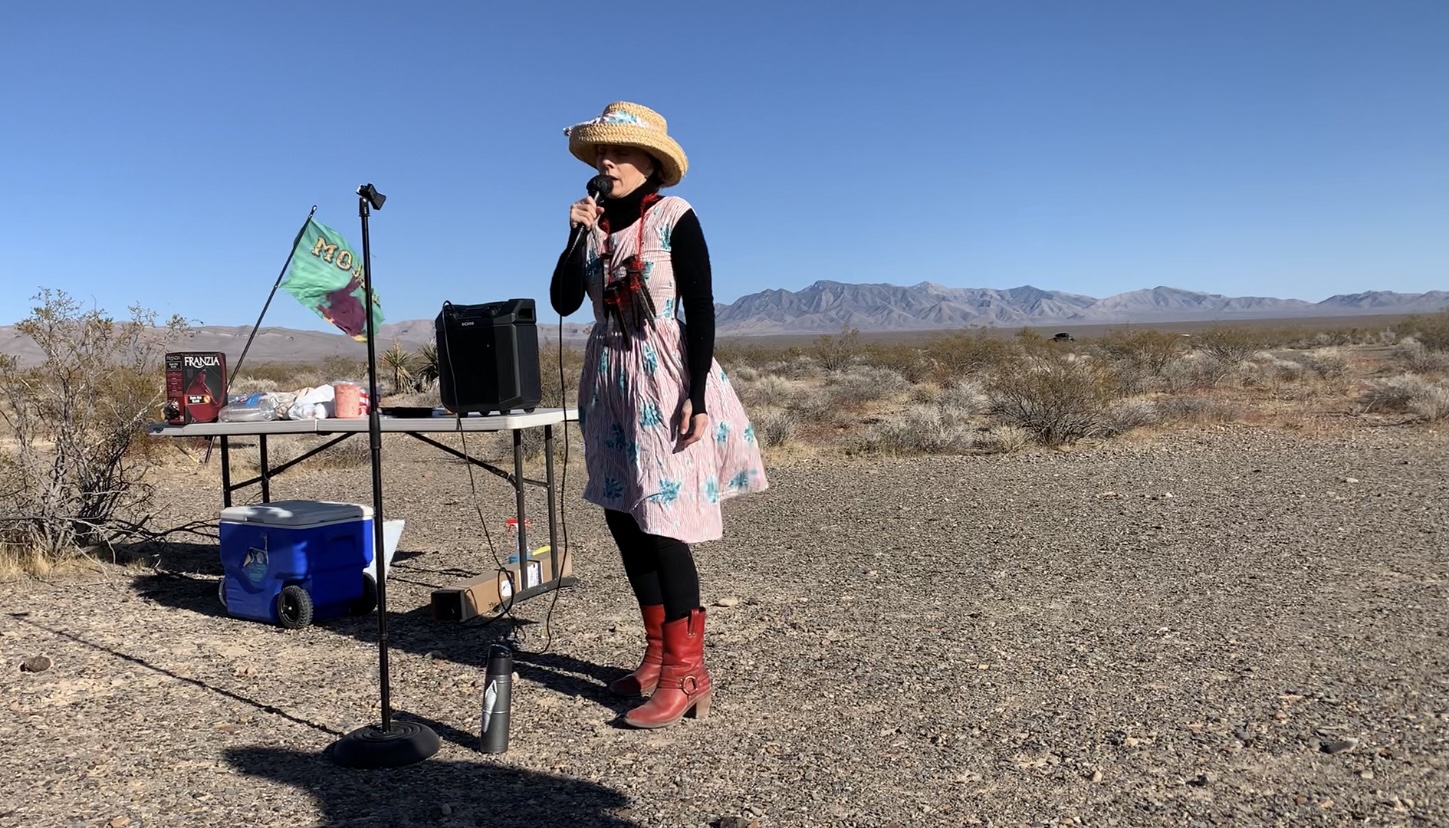
^Elee Oak, Poet at University of Nevada at Las Vegas (UNLV).
UNLV Poet Elee Oak reads: https://www.youtube.com/watch?v=CQPq3F5Bi5Q&feature=youtu.be
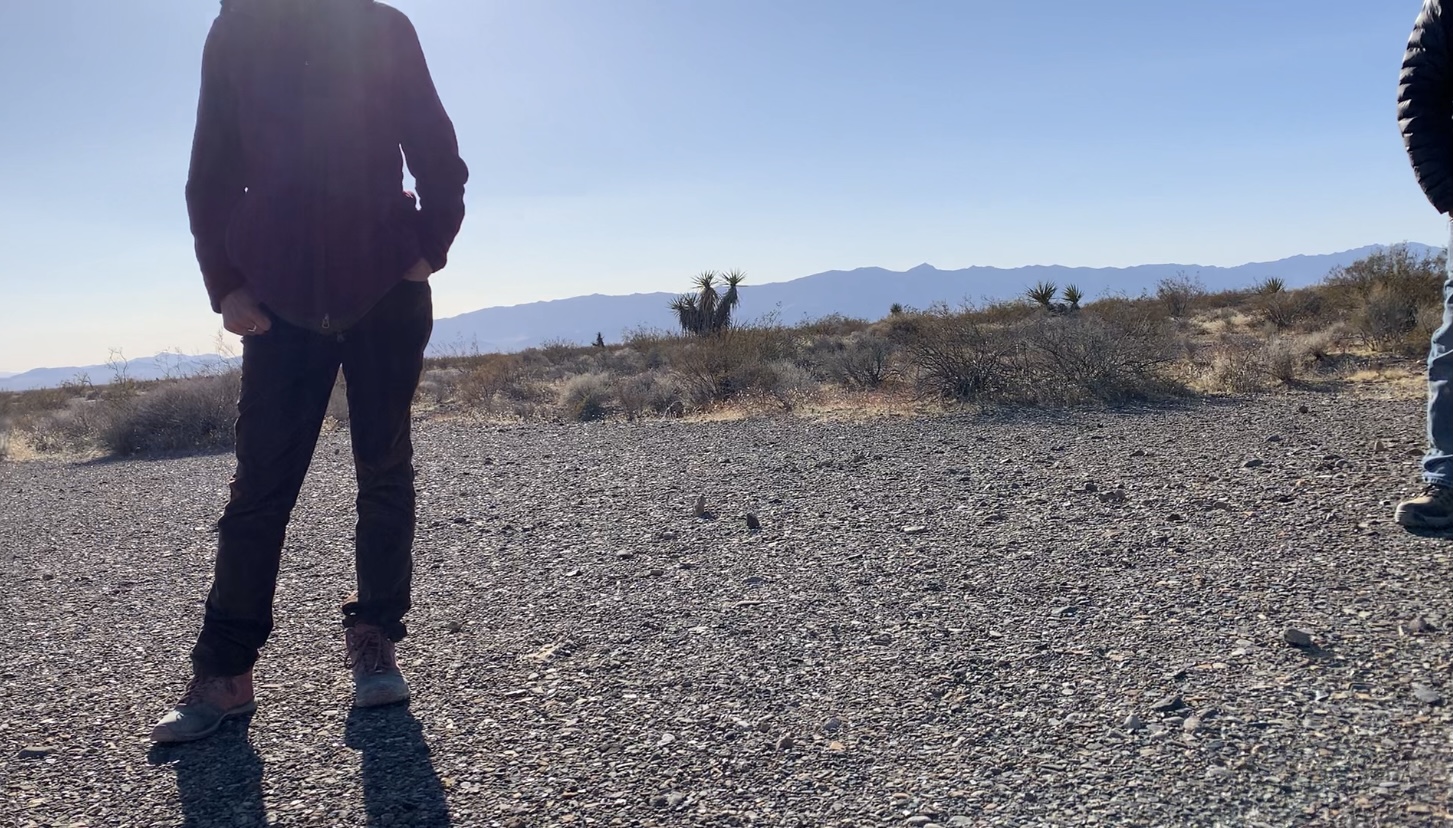
^People listen to the poets, on an ancient desert pavement natural soil, about to be destroyed by a utility-scale solar project.
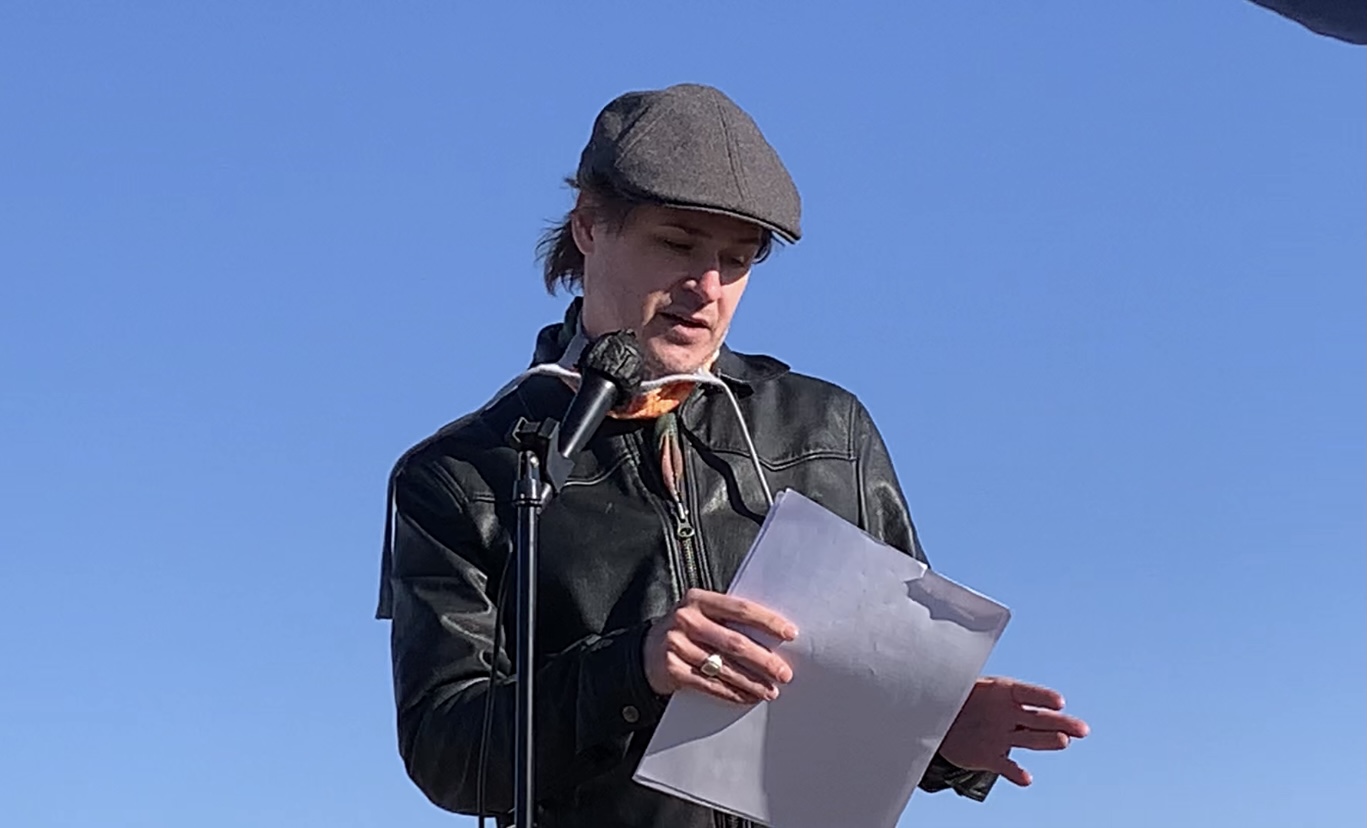
^UNLV Poet Andy Nicholson reads his work at the Poet Rally, Yellow Pine Solar Project site.

^Andy Nicholson reads.
UNLV Poet Andy Nicholson reads: https://youtu.be/NkgLRuojm3U

^Elee Oak reads on this soon-to-be-disturbed Mojave Desert landscape in southern Nevada.
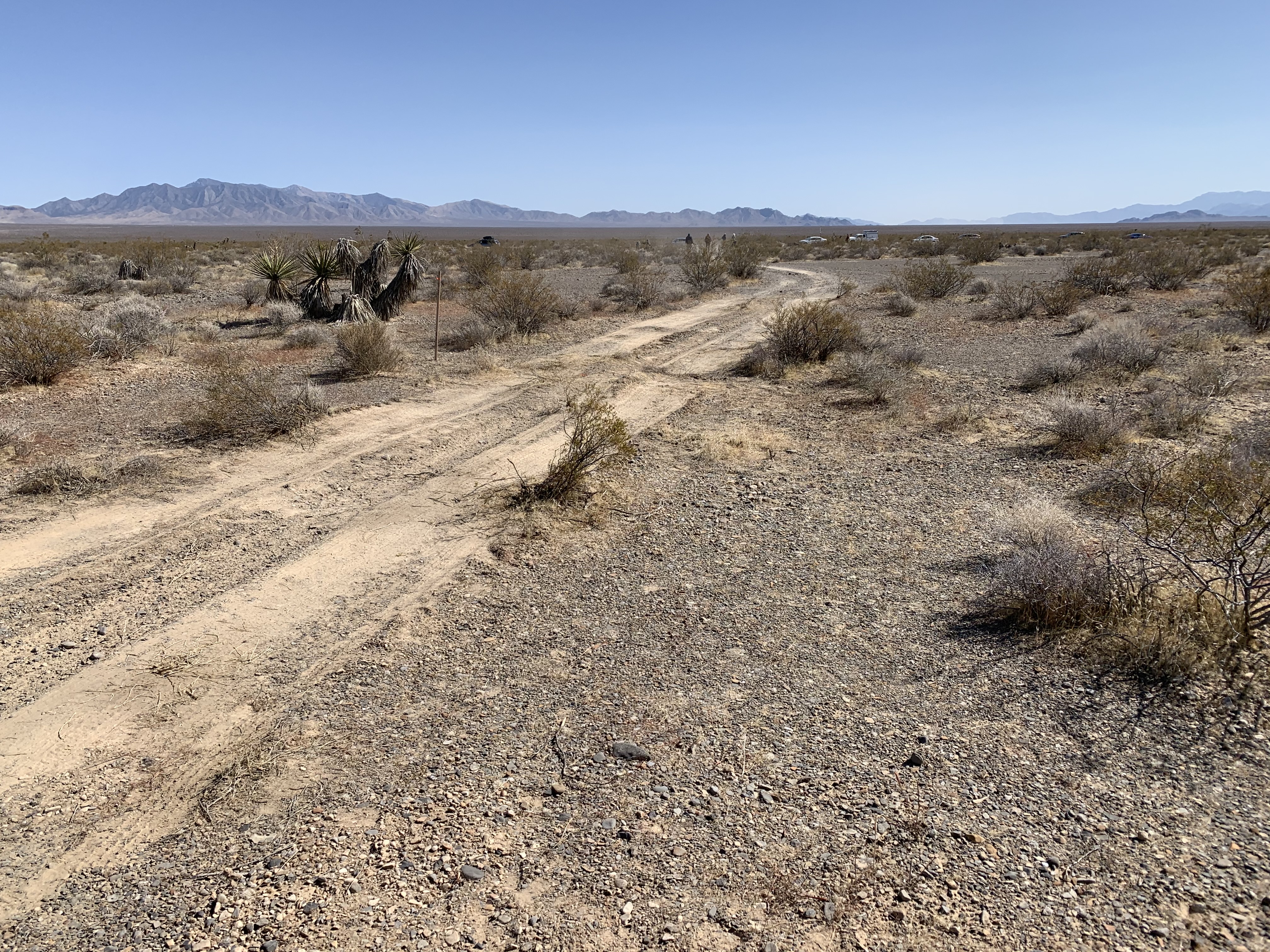
^New road bulldozed into the pristine Mojave Desert as survey stakes go up for construction of the large-scale solar project.
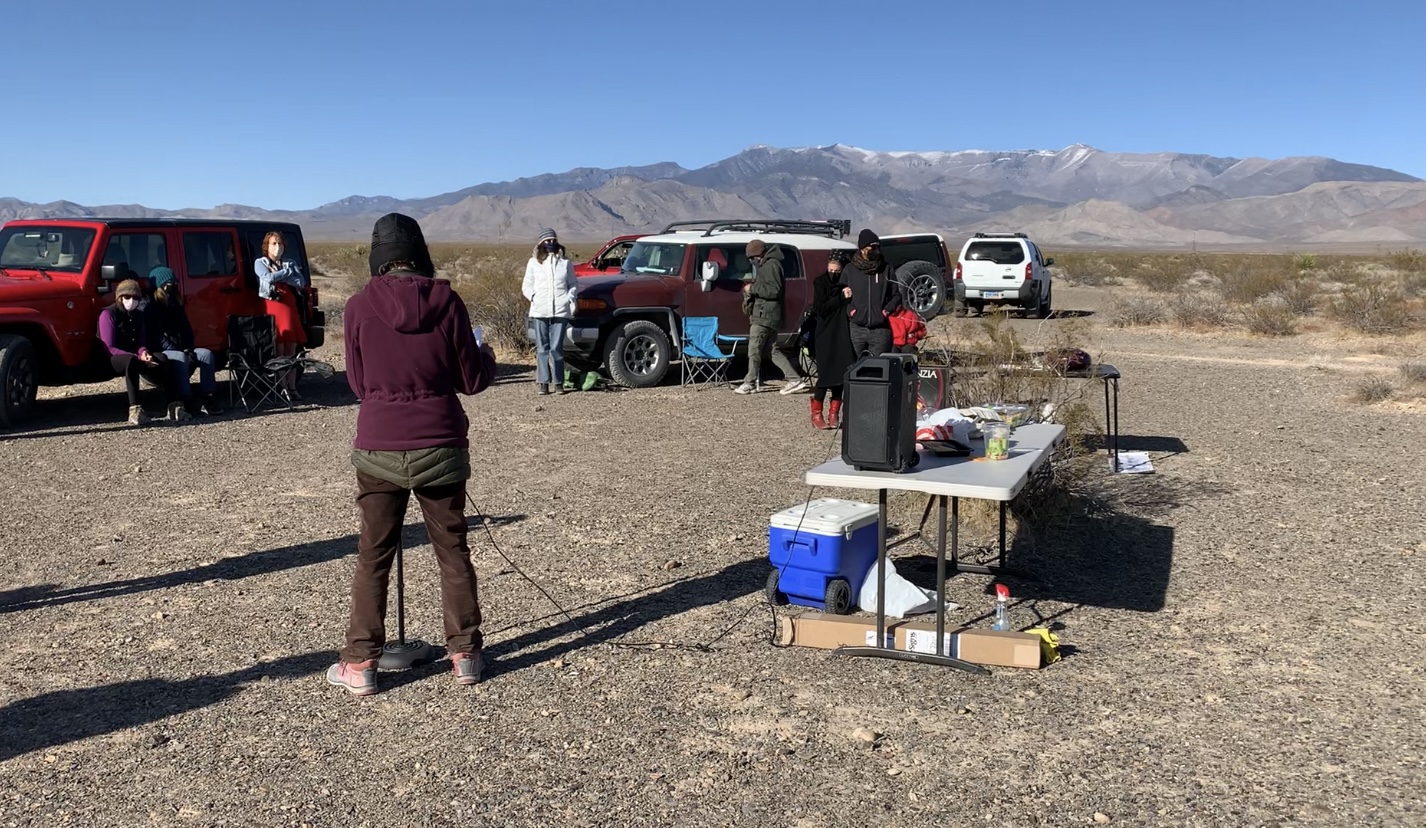
^Poet rally with the Spring Range in the background.
^Laura Cunningham talks about the Mojave Desert vegetation here in southern Pahrump Valley: Nevada Ephedra, Creoste, bursage, and the Mojave yuccas, that will be destroyed by the solar project--these panels need to go on disturbed areas and the built environment. Photo: Judy Branfrom.
^This Place Matters.
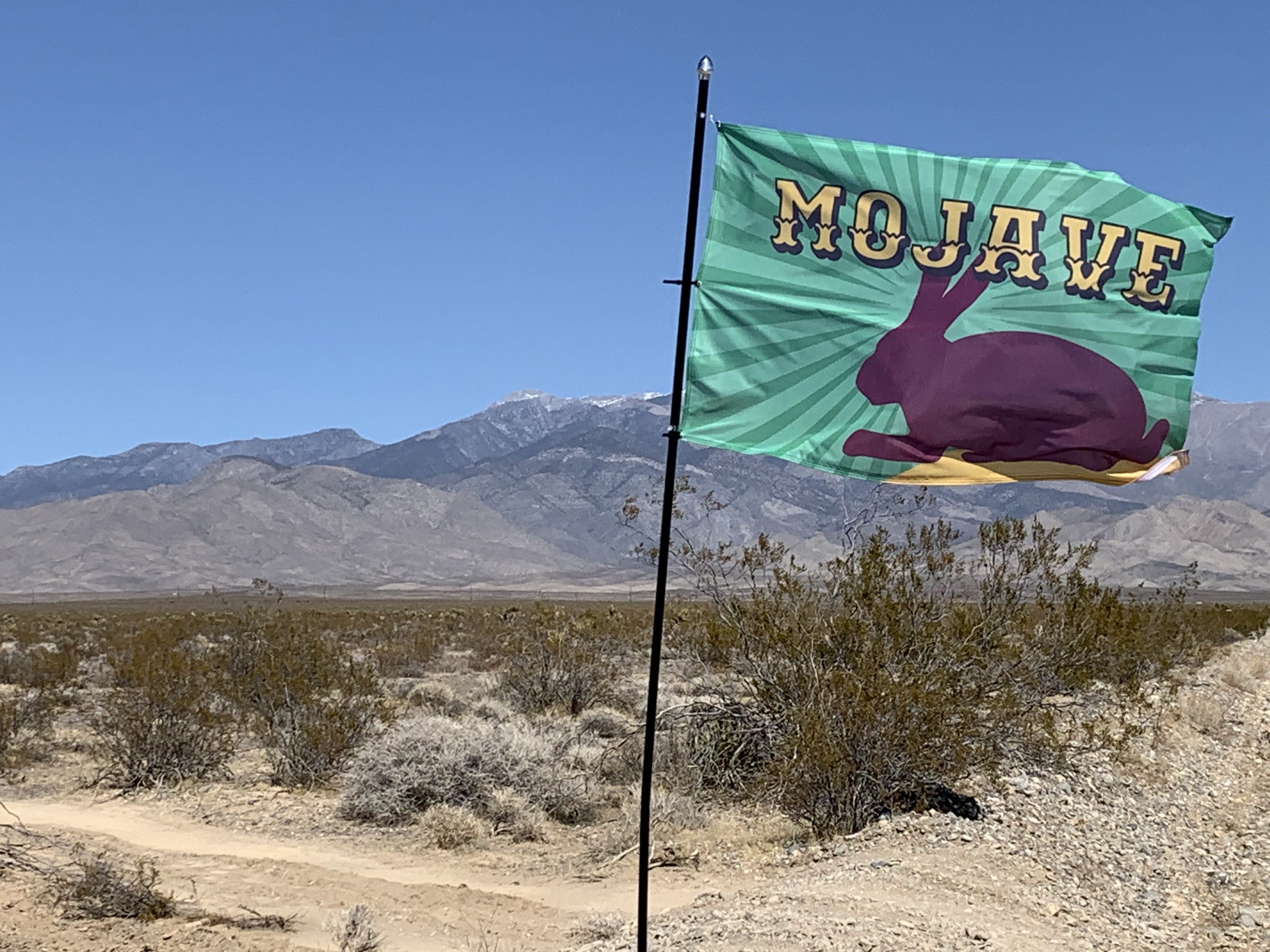
^Mt. Charleston in the background of the Poet Rally at the site of Yellow Pine Solar Project.
Geology of Ancient Desert Soils
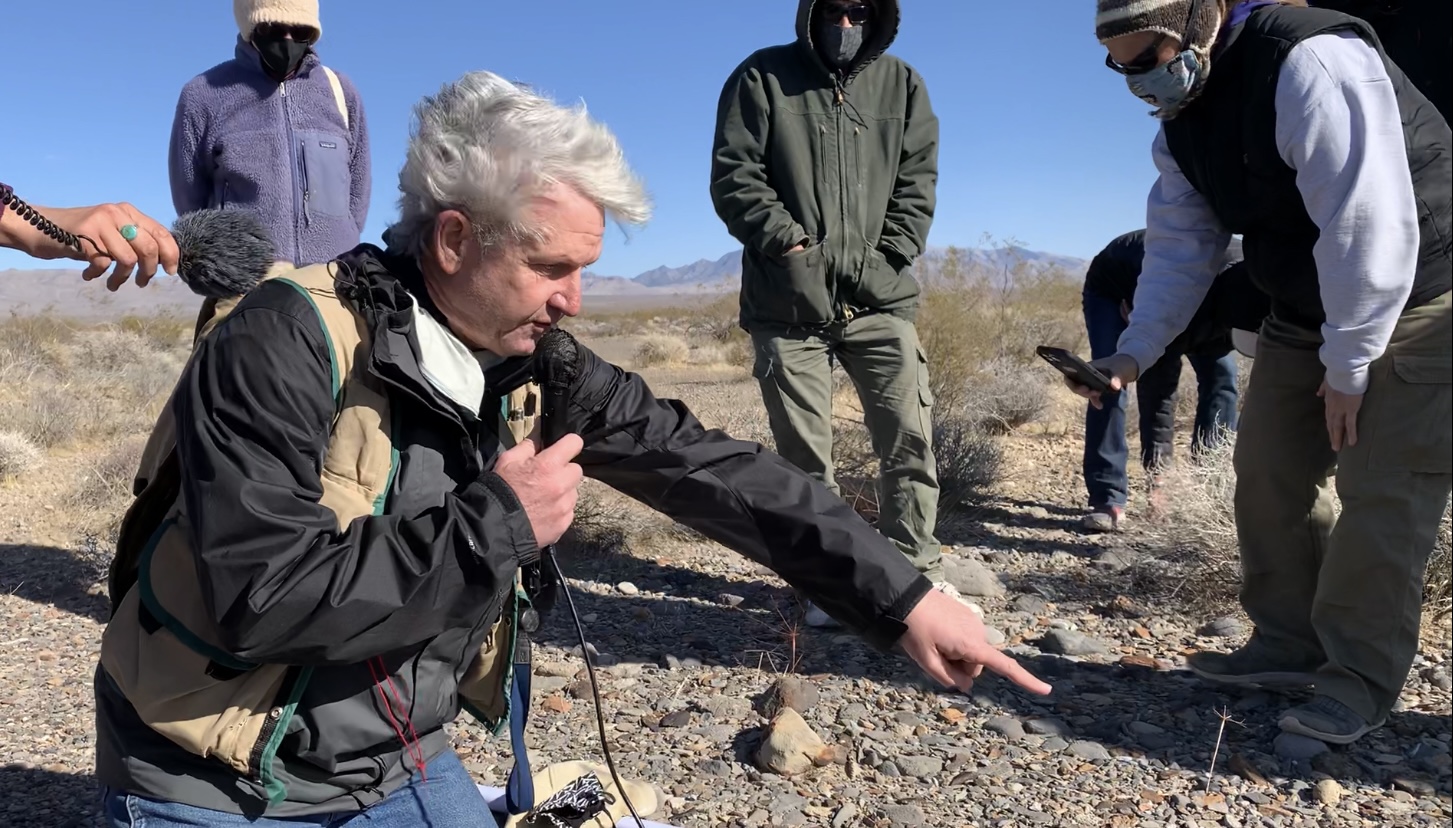
Geologist Matthew McMackin describes how this desert pavement rock soil at the solar project site is 100,000 years old.
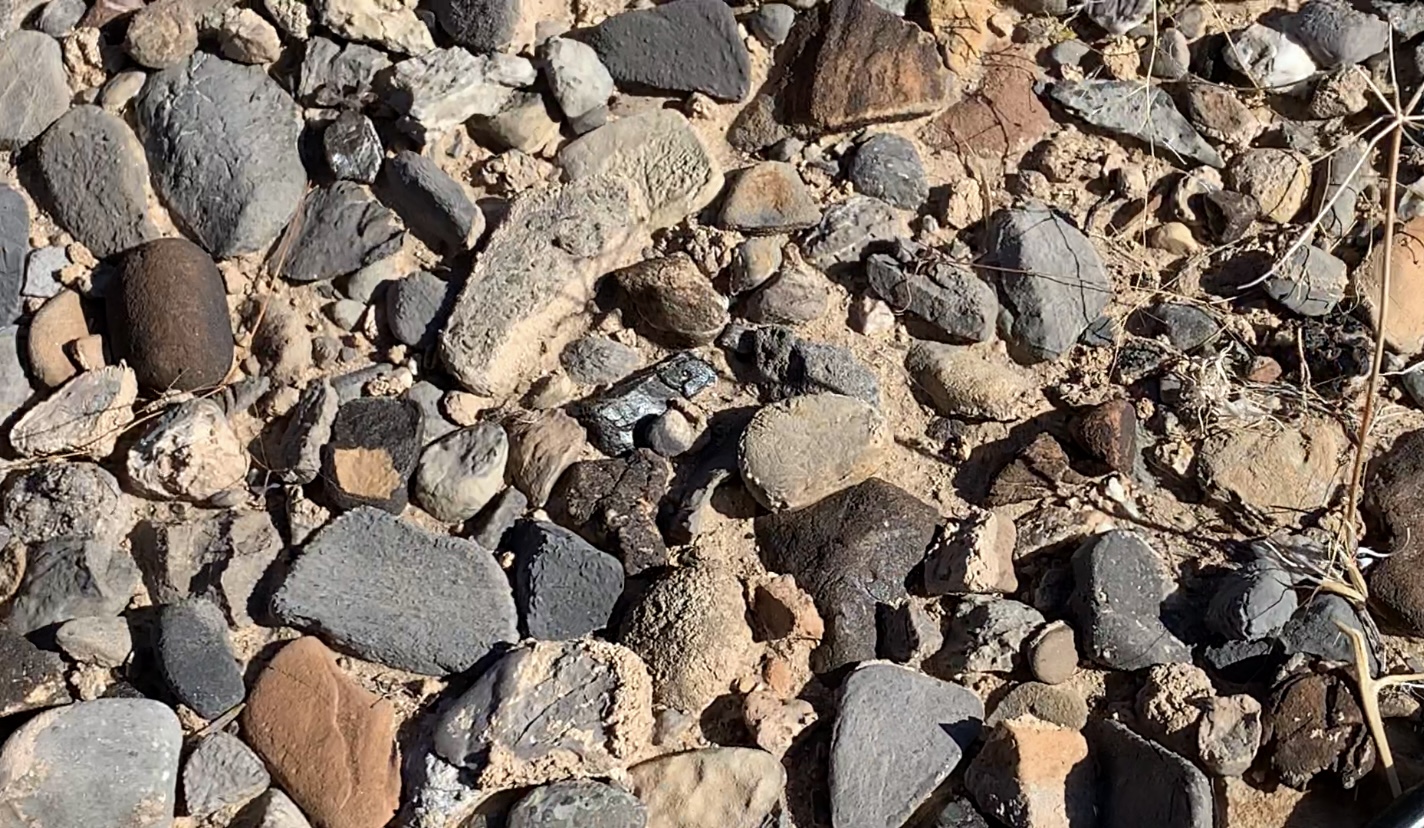
^Matt McMackin shows us that this natural desert pavement surface is 100,000 years old. The winds were strojng this day, yet the scene was not dusty at all.
https://youtu.be/nKFBh0qAK7c - Geologist Matthew McMackin shows us the 100,000-year-old desert surface at Yellow Pine, soon to be disrupted by heavy machinery.

^Matt take s a trowel and digs into the ancient desert pavement rocks, reveleaing loose siltysediments that will blow away in the winds, as well as spongy soil that indicates the metabolic activity of underground biological soil crusts.
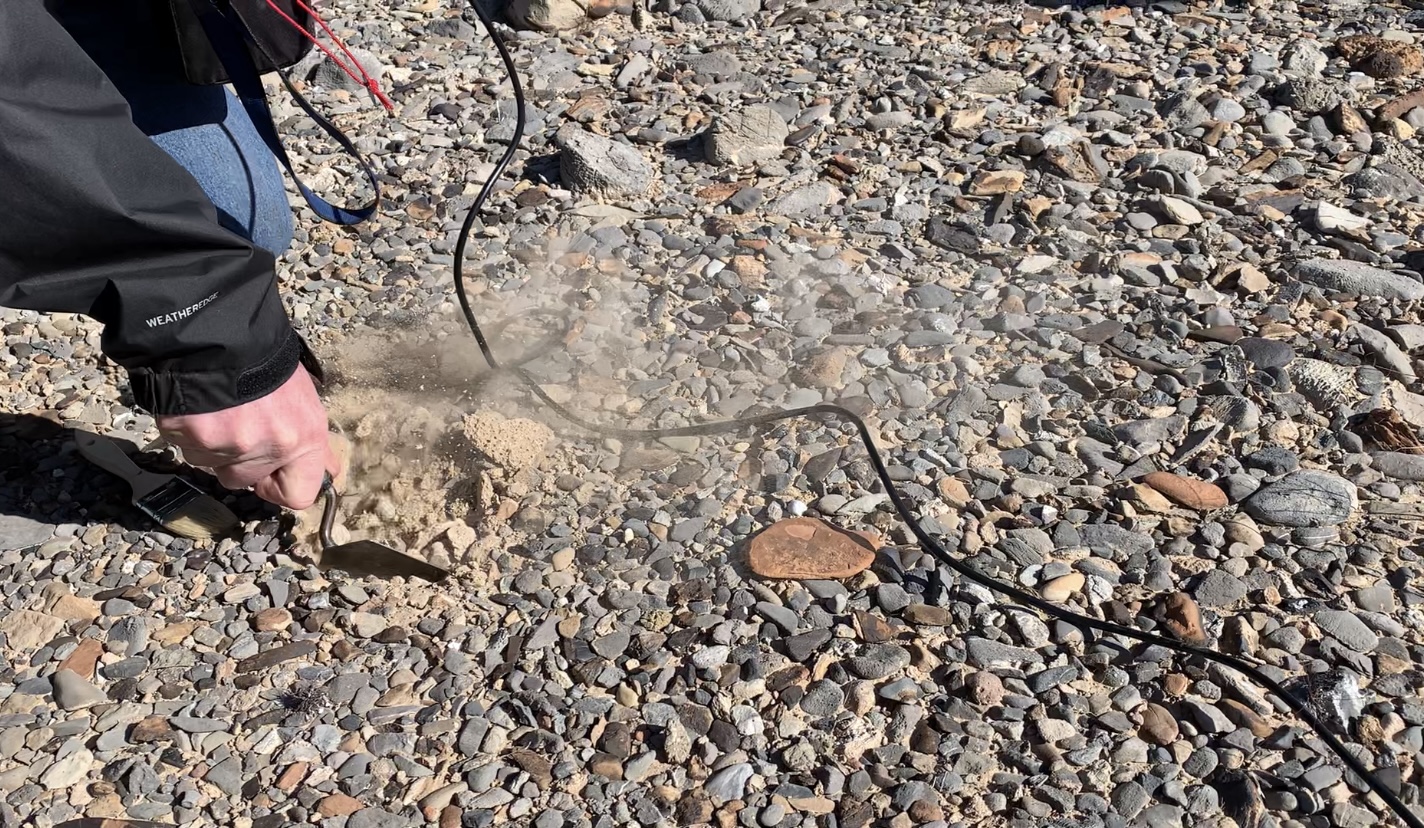
^Look at that poof of subsurface dust in the wind that results when the desert crust and ancient rock soil is disturbed. This will happen on a massive scale when the solar project breaks ground.
^Matt McMackin gives a very informative geology talk on the desert soils which he has mapped here for the U.S. Geological Survey. Photo: Judy Branfrom.
See these maps and publications:
https://pubs.usgs.gov/of/2006/1035/
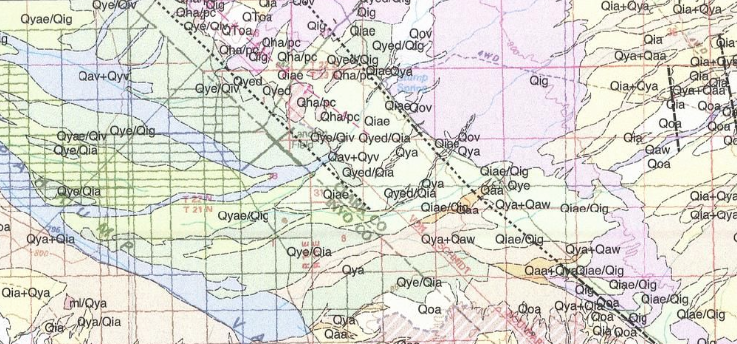
^Detail of the Quaternary surficial geology map of the Stump Springs area in south Pahrump Valley. https://ngmdb.usgs.gov/Prodesc/proddesc_75469.htm
^ Laura Cunningham points out the living but dormant Biological Soil Crusts on the desert here, that sequester Carbon underground. Until we recognize and preserve these ancient desert soils, constructing thousands of acres of solar projects on these will only release Carbon into the atmosphere. Photo: Judy Branfrom.
Dormant Biological Soil Crust bubbles out of the arid desert soils at the project site. Disturbing these will release greenhouse gas emissions. Photo: Judy Branfrom.
Cathedral Canyon
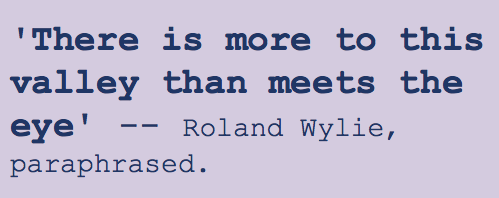
Shannon Salter researched the unique history of this private parcel near the solar project site and Stump Springs: once a ravine filled with spiritual nooks, artwork, and a plcve for contemplation. A desrt shrine in ruins. We took a tour of the area, now run-down and only a vestige of its former glory. But very interesting nonethe less.
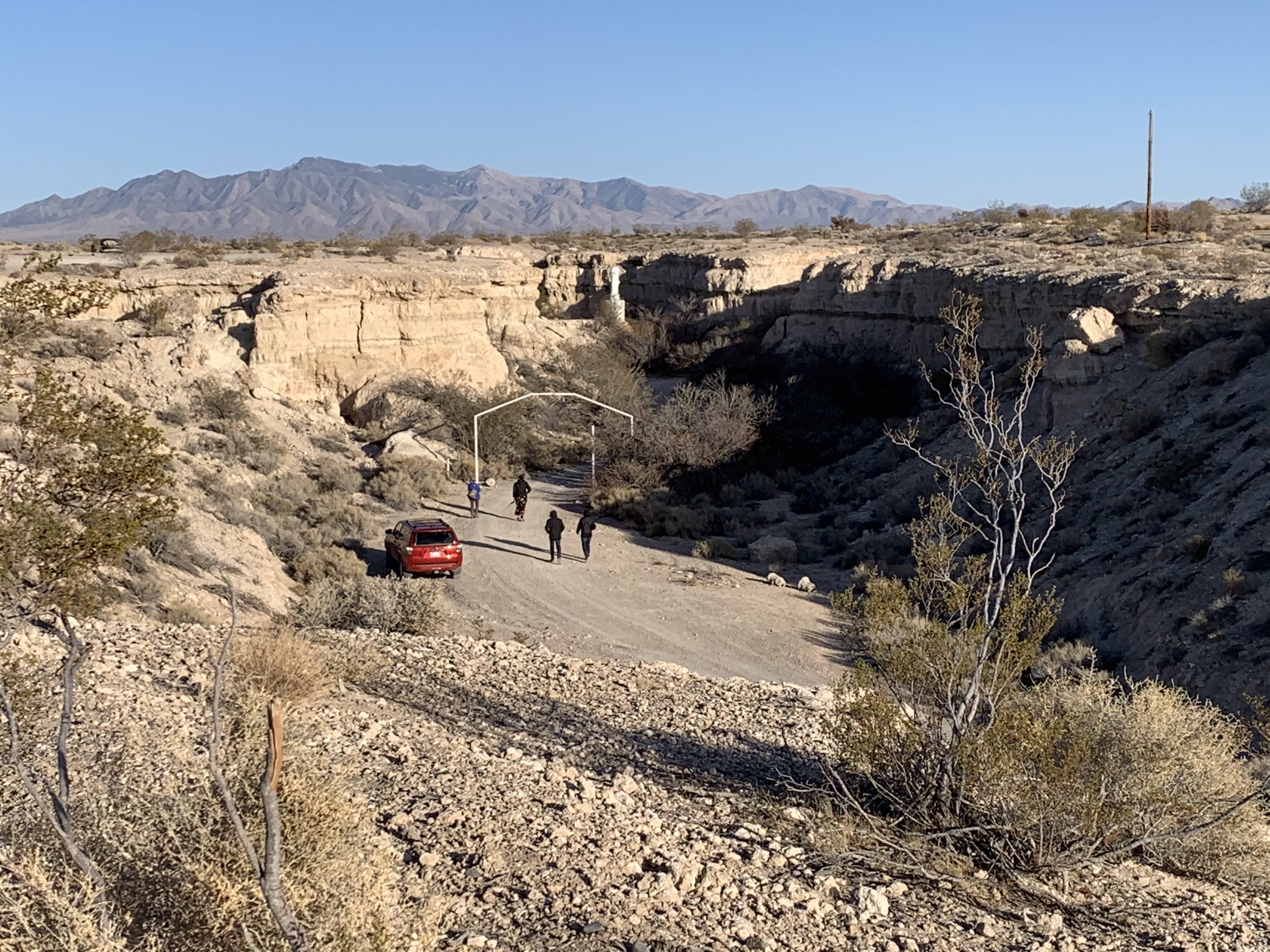
^We walk into the remains of the once glorious Cathedral Canyon, near the Yellow Pine Solar Project site.
Roland Wylie made this desert box canyon into a church and work of art. It later fell into disrepair. But you can still visit the place.
We respected the grave of the "Last Renegade Indian" in Nevada, Quehoe, who hid from settler-colonizers, murdered many, and was never caught. He hid in a cave near the Hoover Dam and watched his traditional homeland Colorado River be developed for huge energy generation. Roland Wiley purchased his mummified remains after they were finally discovered, and gave them a final burial.
https://www.osieturner.com/2012/11/the-devastation-of-cathedral-canyon-and.html
https://pvtimes.com/community/one-mans-vision-reduced-to-ruins/
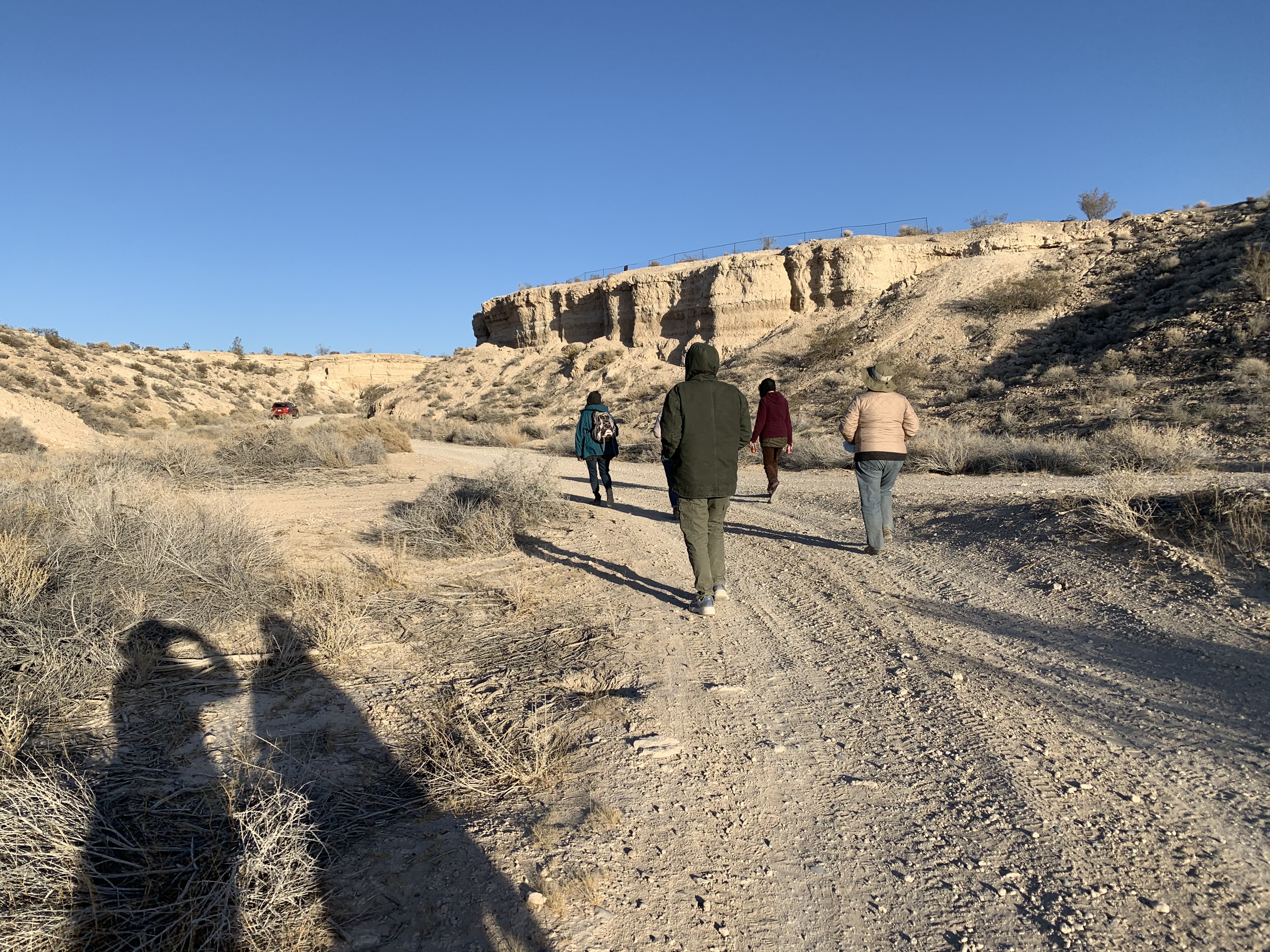
^We respectfully enter the natural box canyon in southern Pahrump Valley--Cathedral Canyon.
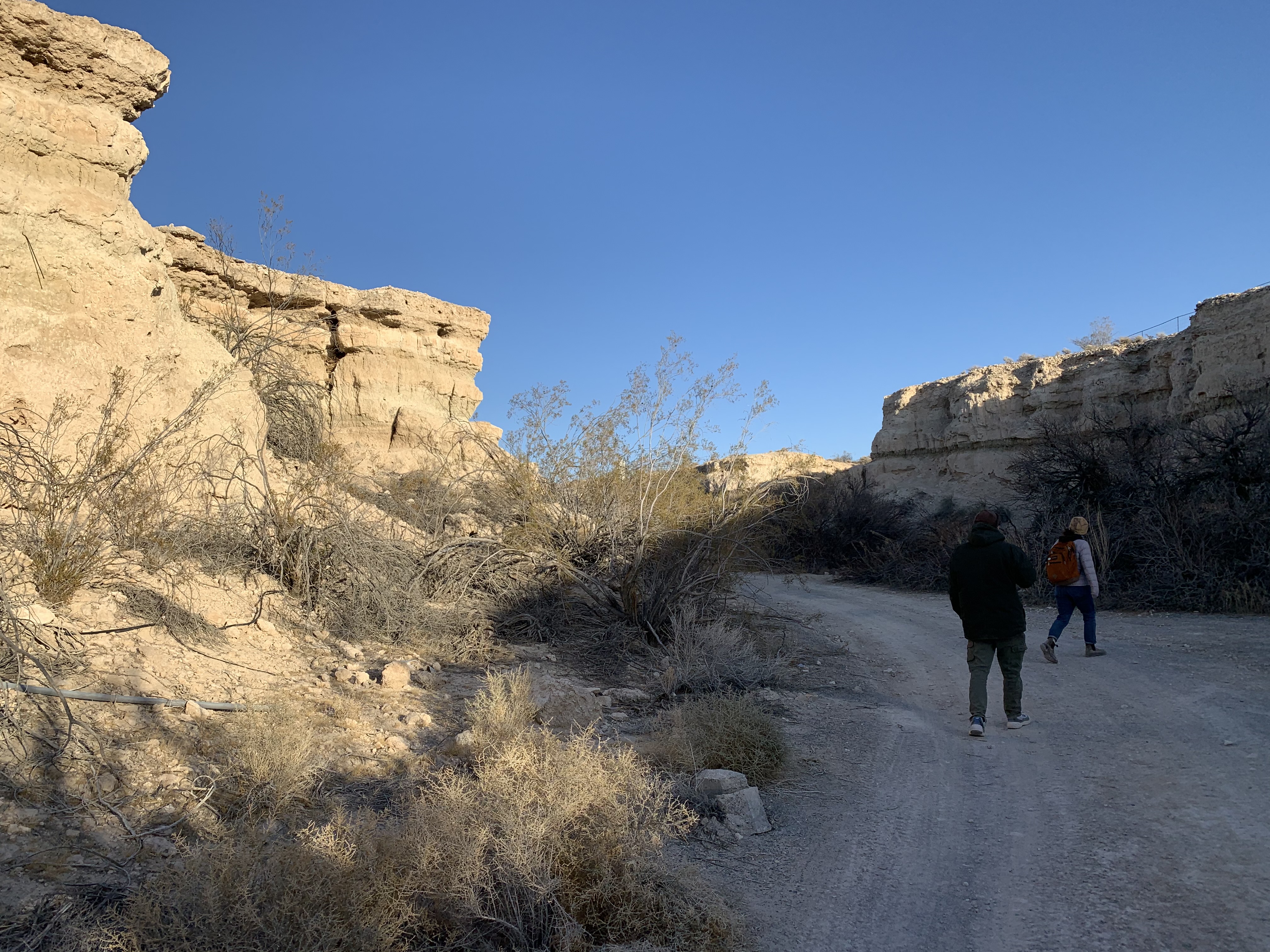
^Cathedral Canyon still holds natural beauty.
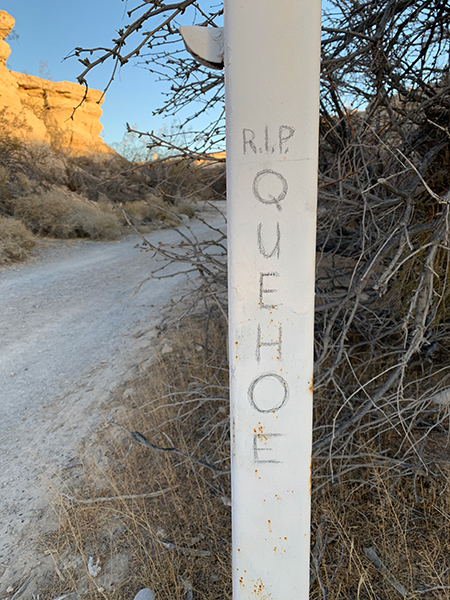
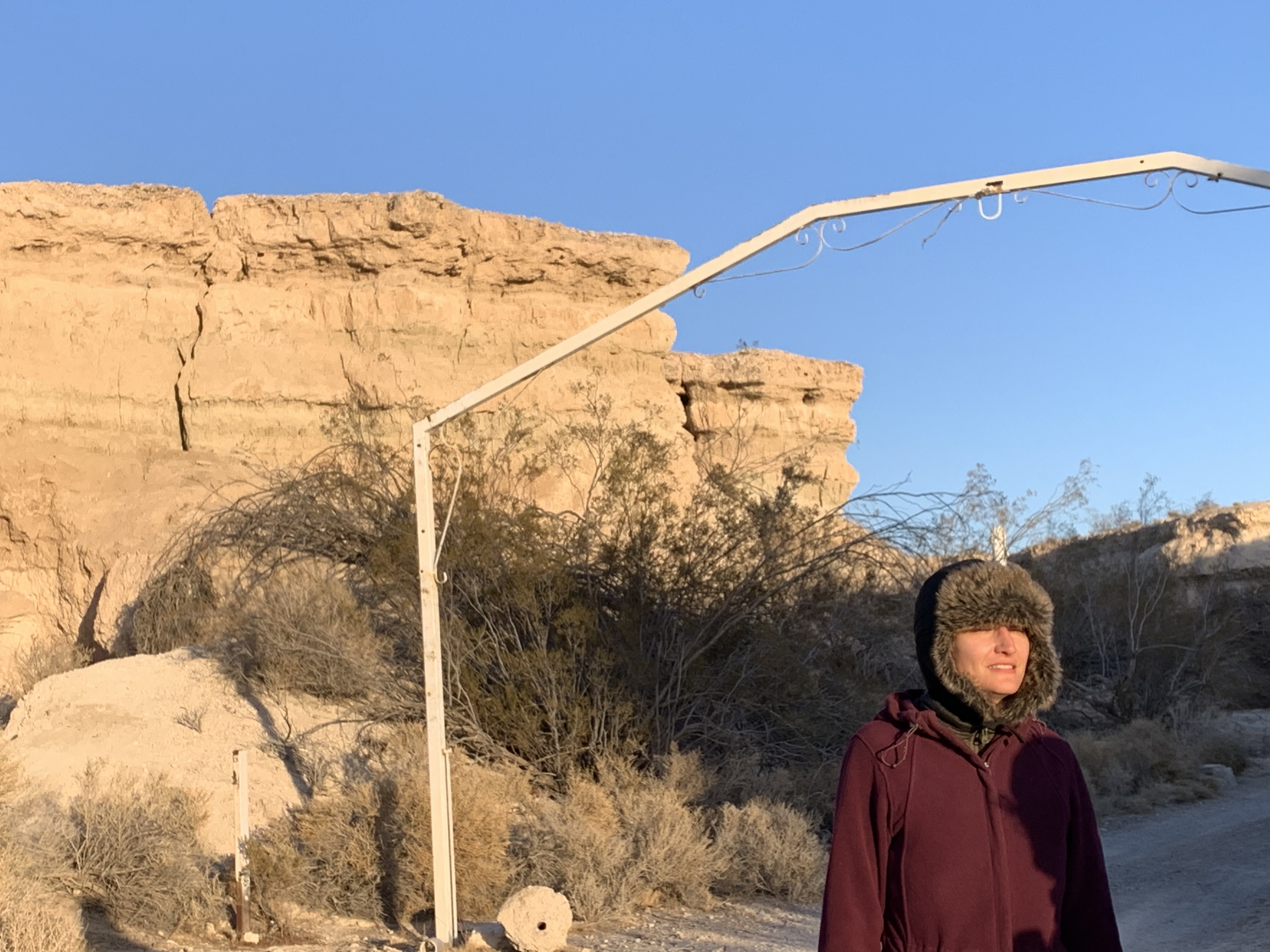
^Shannon Salter reflects on Quehoe and the history of this valley, in Cathedral Canyon.
Campfire and Campout on adjacent public lands: There was a socially distanced campfire and campout with hotdogs, smores, and refreshments; an opportunity to further appreciate and enjoy the landscape. People brought instruments, food to share, and a good time was had.
